Introduction
Sometimes you need a pocket torch and sometimes you need a head torch. And then, there are times your usage scenario is so versatile and complex that you need to cover all possible situations.
We all have to make compromises with the EDC torch we carry and choose the one that is most likely to serve our needs for the day, but what if there was a torch that was so versatile it could eliminate the need to choose?
Brinyte aspires to provide the answer to that question with their new Brinyte HL16 Noctua.
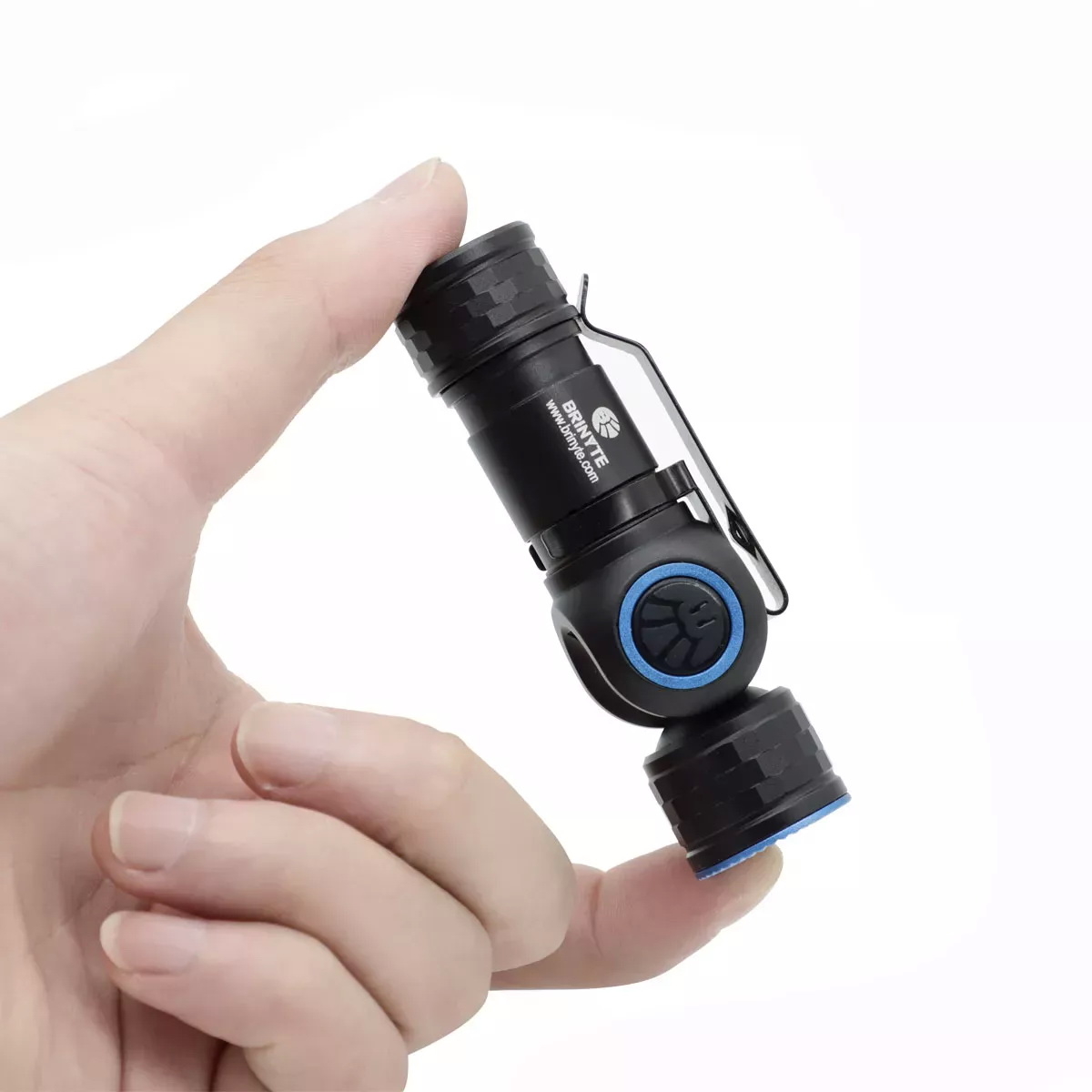
The Brinyte HL16 Noctua is a headlamp like no other that I have seen, as its head rotates from 0 to 90 degrees, including 3 intermediate positions, thus providing unparalleled versatility and eliminating the need to compromise when choosing your EDC torch type.
But what compromises did Brinyte have to make, if any, to realise such a unique and complex design? Read ahead to find out.
Unboxing
The Brinyte HL16 Noctua comes in a very nice cardboard box that is held closed with a blue paper ribbon, bearing the company's logo.
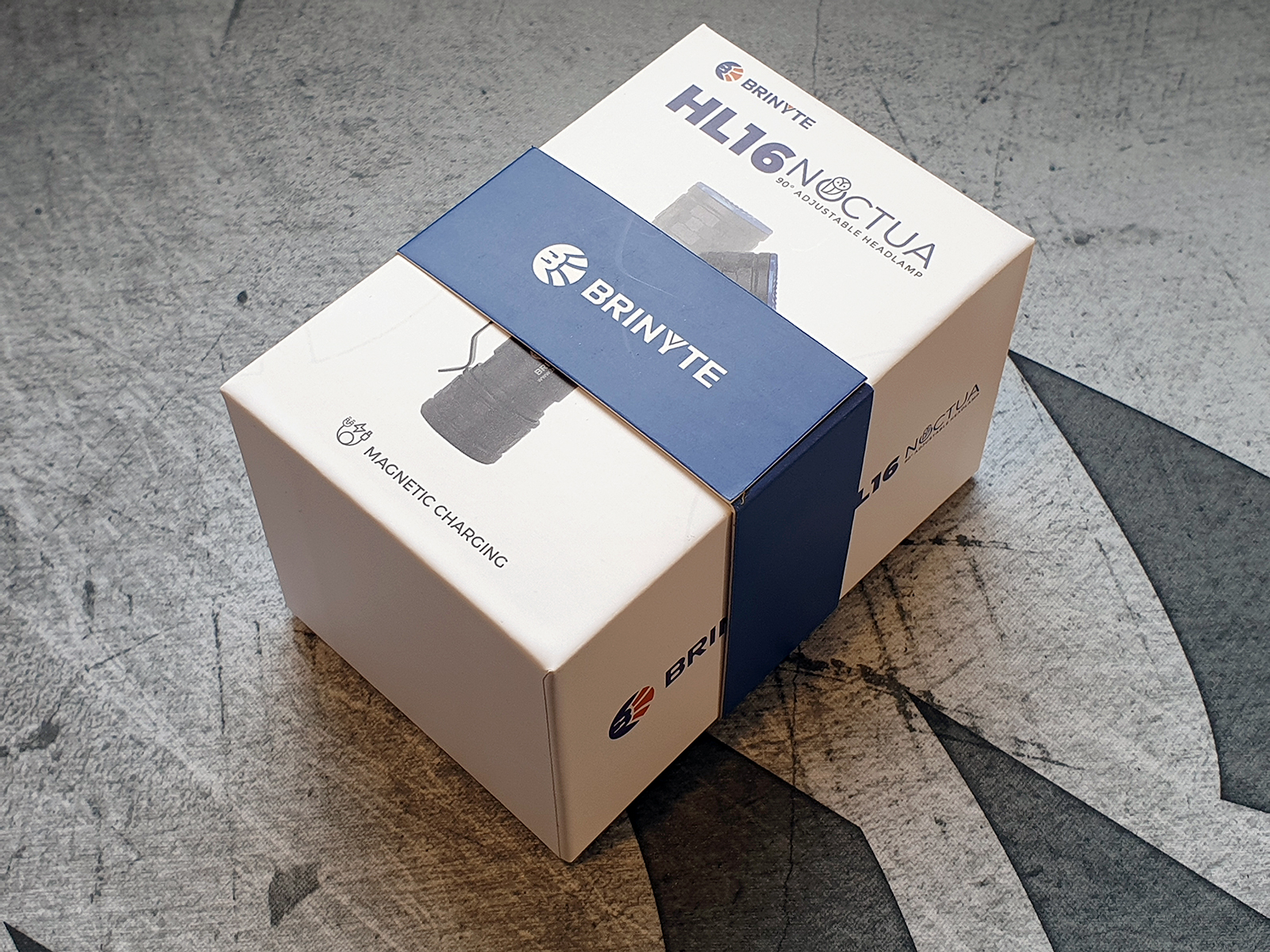
The front of the box features a photo of the torch, emphasizing its articulated head and the magnetic charging capability. The back is less exciting, but provides a useful QR code to find out more about the product.

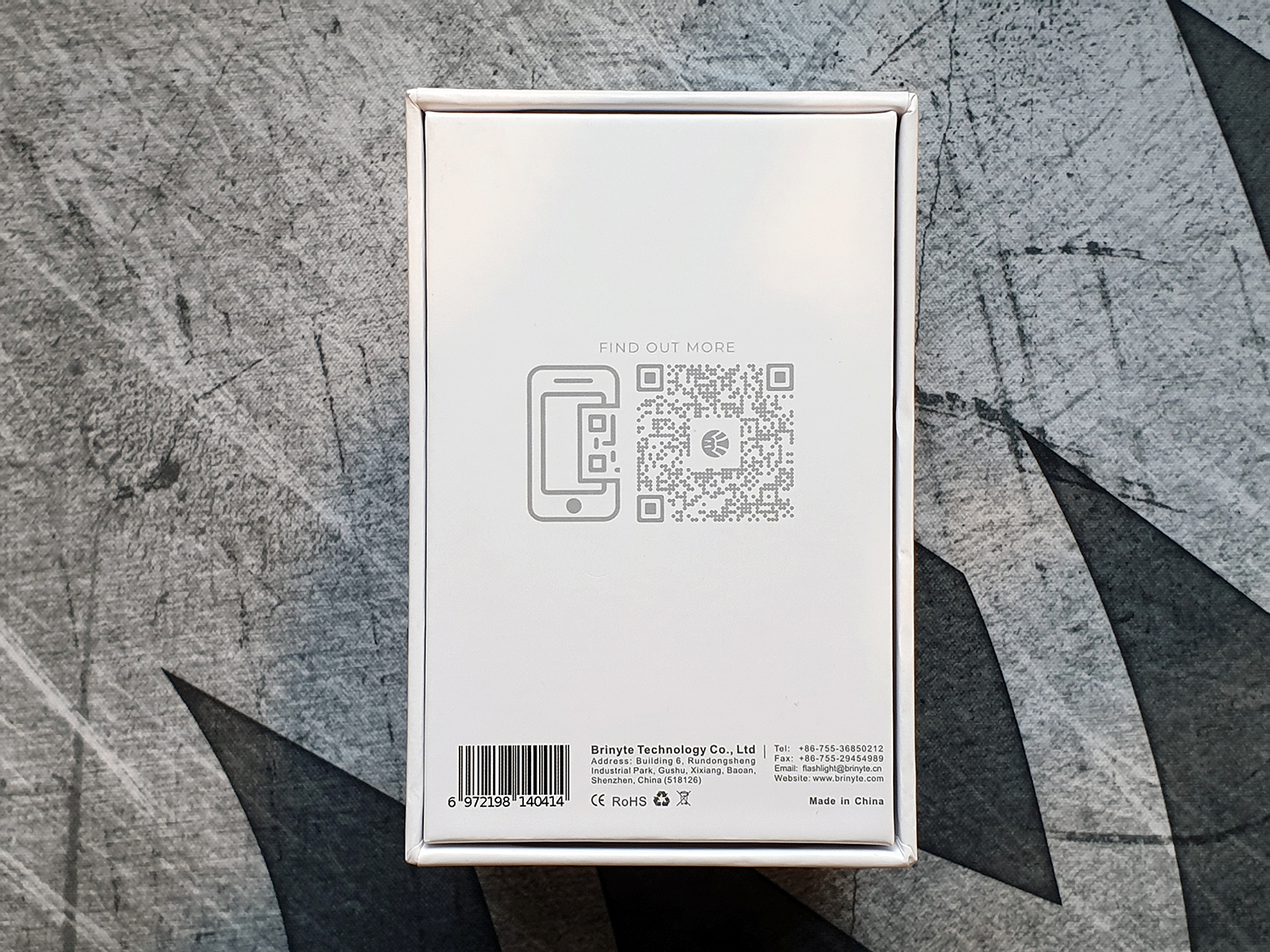
The top and bottom of the box are plain white, while the longer sides feature the name of the torch and one of them has a photo of the torch mounted on the included head strap.


Upon opening the box we find a card, explaining that the battery is already inside the torch, but insulated from the tail cap by an insulation film. The film has to be removed before the torch can be used.

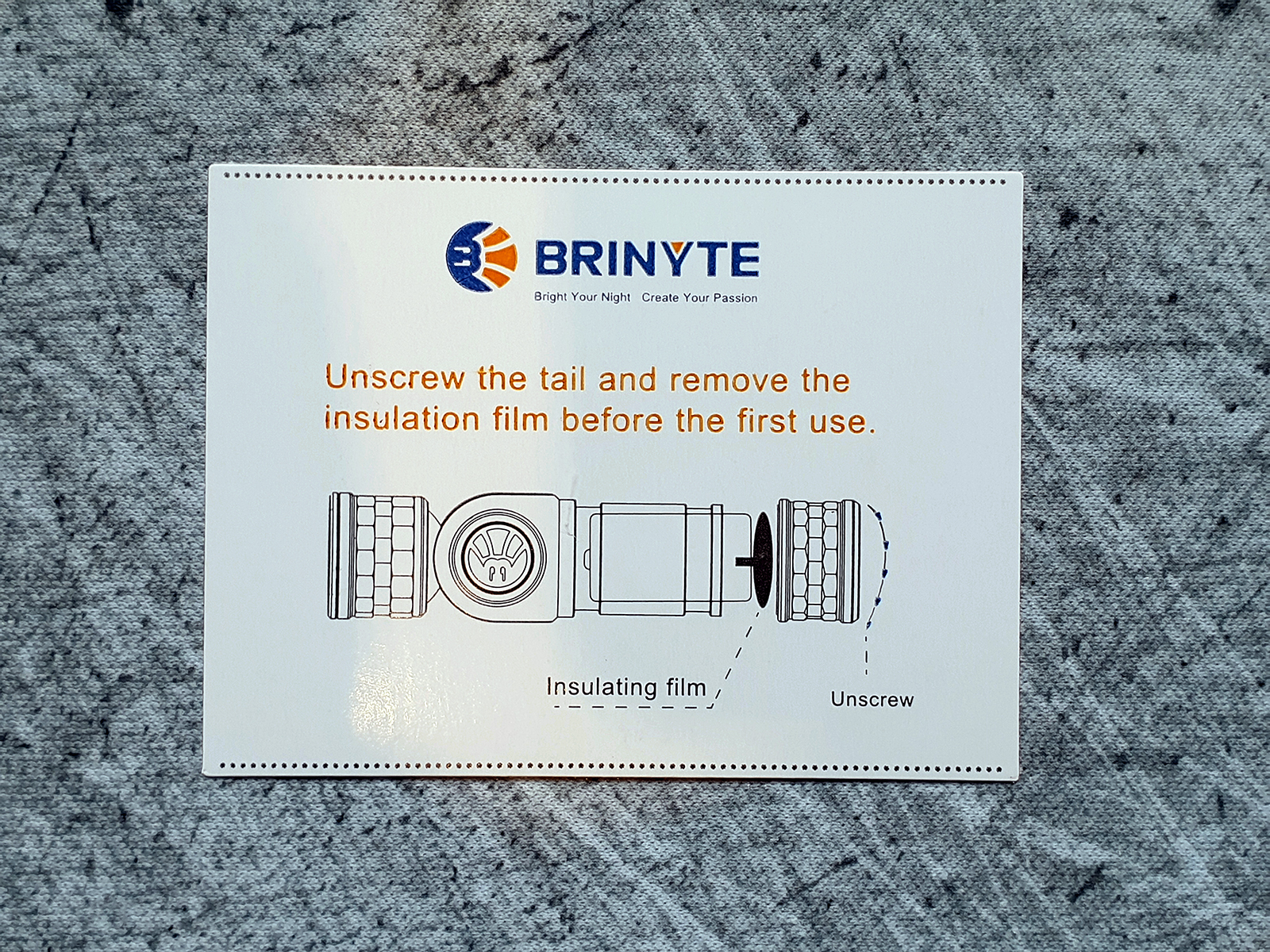
Inside the box we find a head strap, a magnetic charging USB cable, 2 spare O Rings and 2 leaflets.
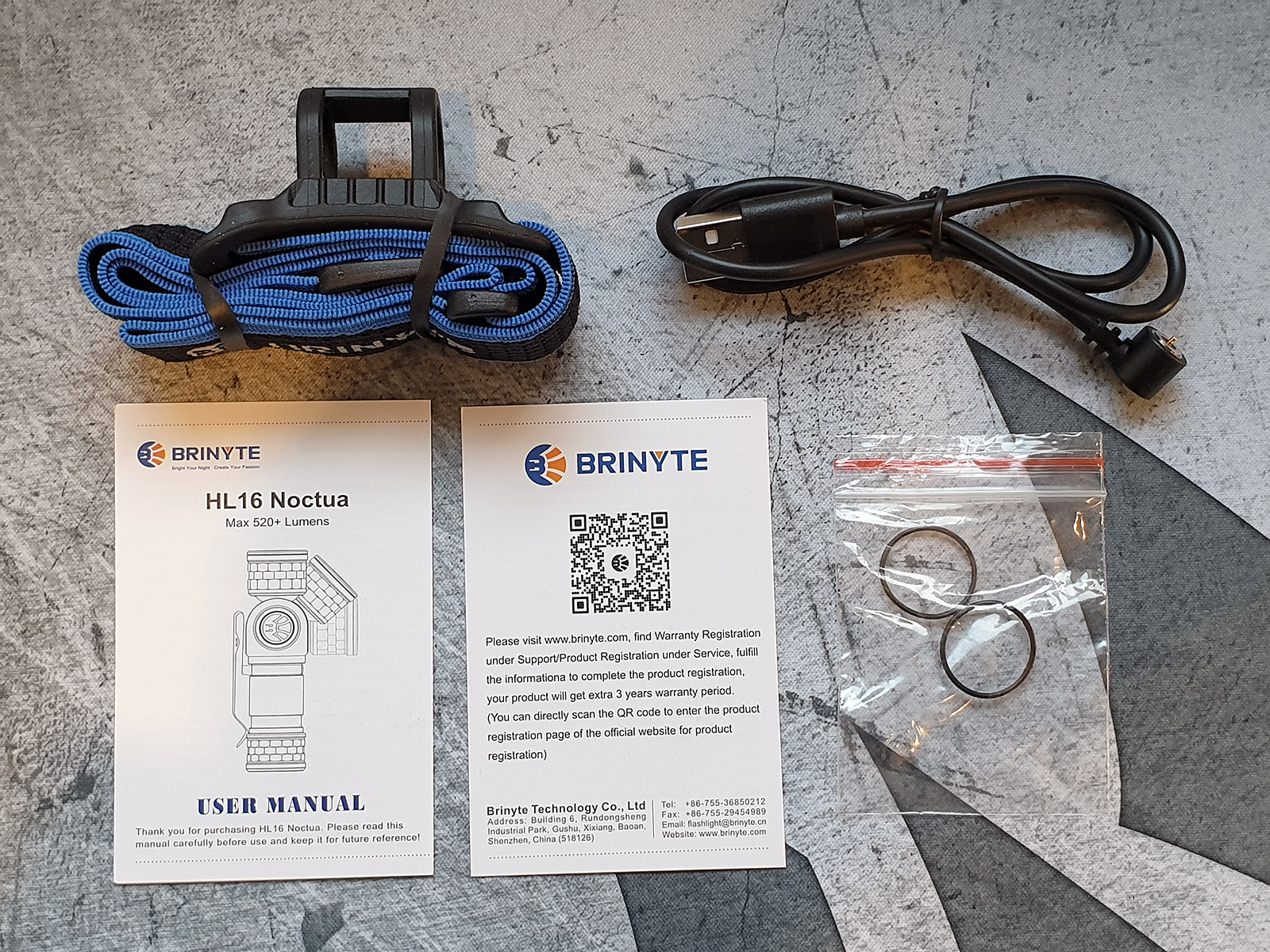
One of the leaflets is the warranty registration card which will allow the owner of the torch to extend its warranty from 2 to 5 years, free of charge, by registering the product on the company's website.


The other leaflet is the user manual, which is easy to understand and includes helpful illustrations.


The magnetic charging cable is 53cm long, including the plug and magnetic head. It is rather stiff and not at all like the much nicer charging cable that is included with the Brinyte PT18pro Oathkeeper, which is supple, sleeved, significantly longer at 102cm and features an illuminated magnetic charging tip. This is a definite downgrade from the magnetic charging cables of previous Brinyte models. Thankfully, the much nicer cable included with the Brinyte PT18pro Oathkeeper is compatible with the Brinyte HL16 Noctua.
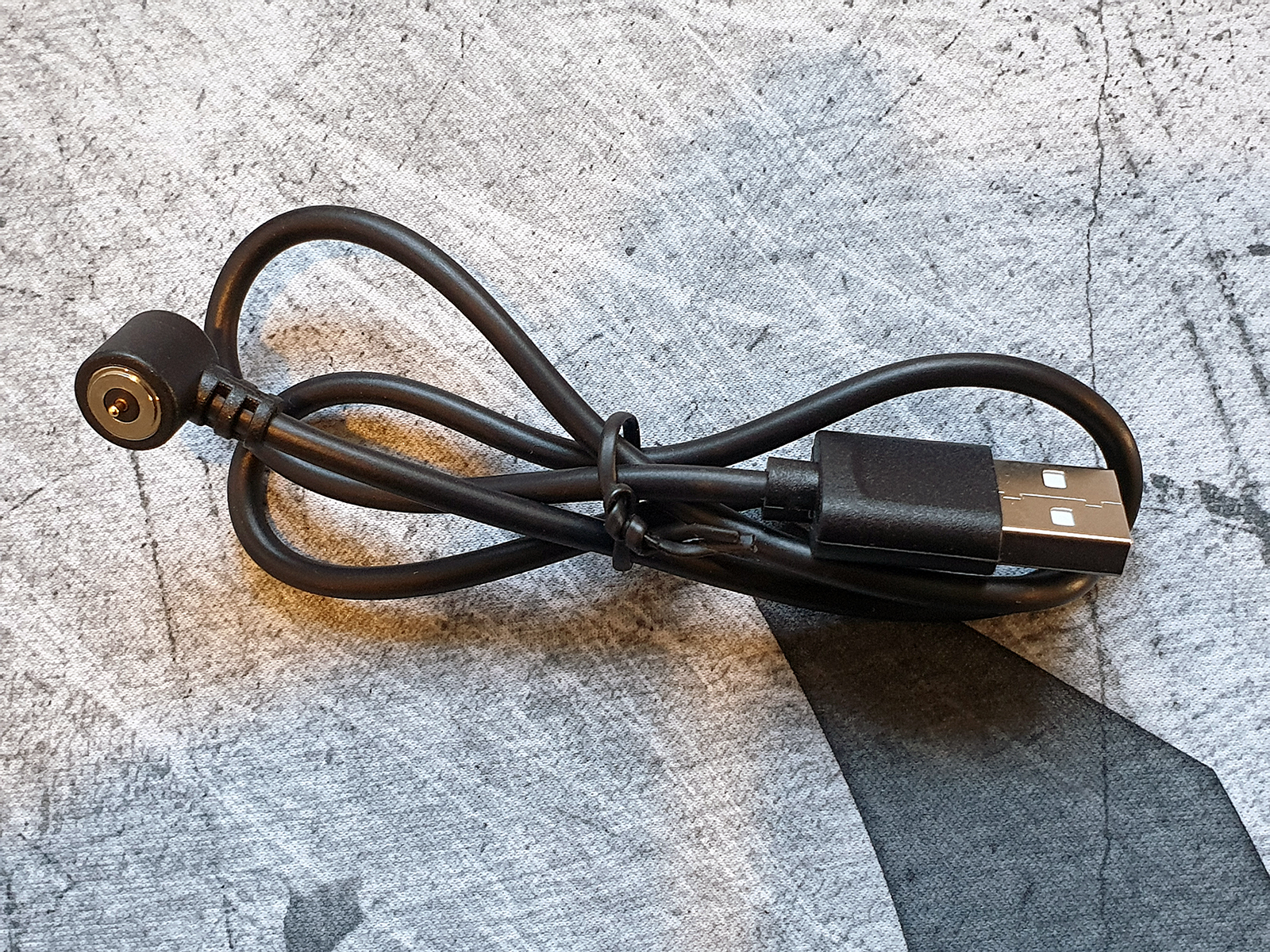
If the charging cable is a bit disappointing, the head strap makes up for it. It is very well made, has a good quality rubber cradle for the torch and adjustable size. The weaving is elastic and features ventilation holes which are a big help in warm weather.

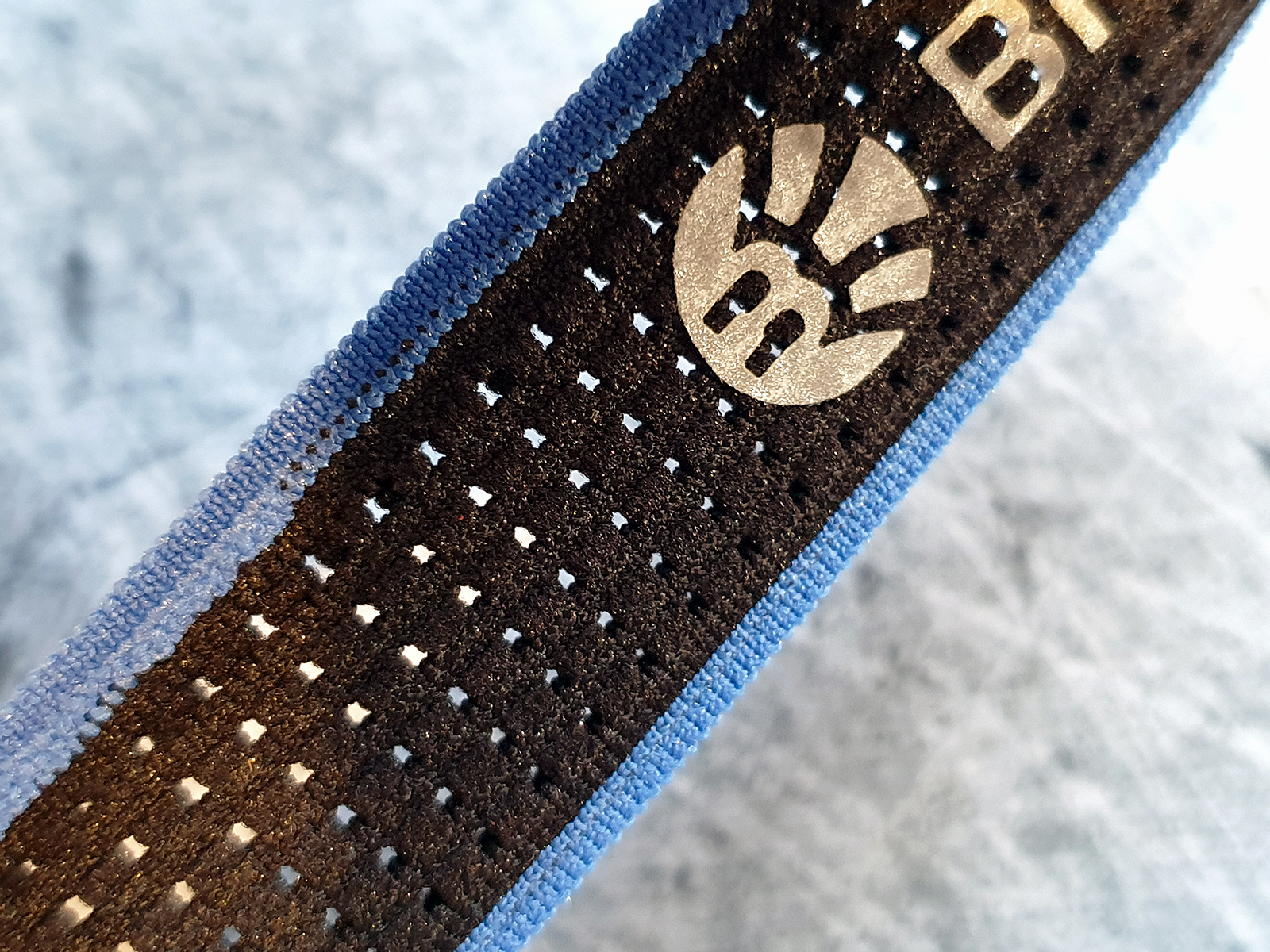
Finally, the torch itself! The Brinyte HL16 Noctua features a unique design, with an articulated head that can turn from 0 to 90 degrees. It is made of black anodized aluminium, with blue accents and has a large rubber button with the company logo engraved on one side and a magnetic charging connection point on the other. The head and the tail of the light feature a faceted milling design that provides both added grip and aesthetics.

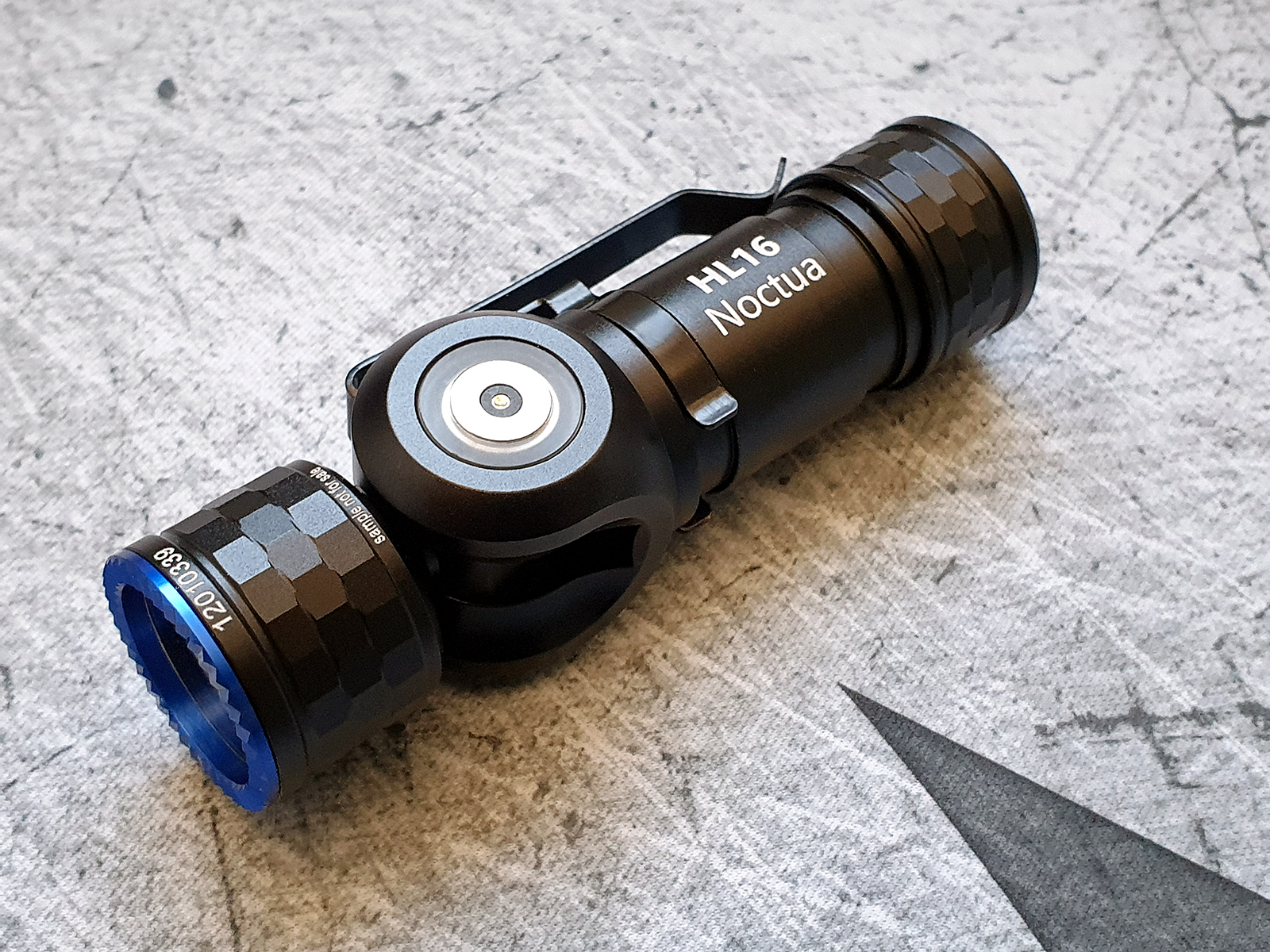
The articulated head is designed and executed with precision and definitely adds to the value and - I am sure - to the manufacturing cost of the torch. There are several detents visible, which means the head will not only stop in the 0 and 90 degree position but also in some positions in between.
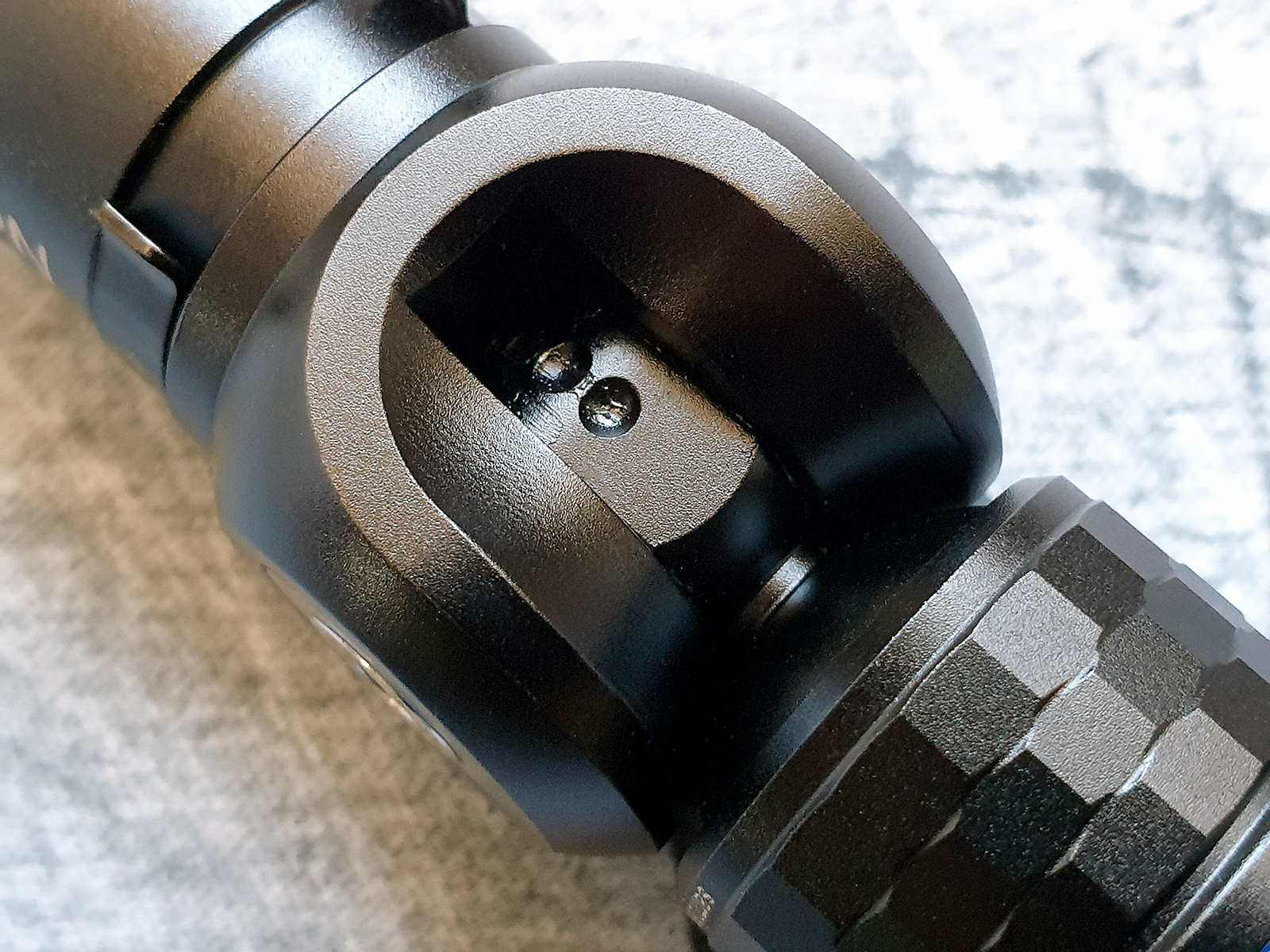
The clip is sturdy, thick and well designed. It comes positioned in the bezel up carry orientation and is as deep carry as can be, allowing for the articulated head.
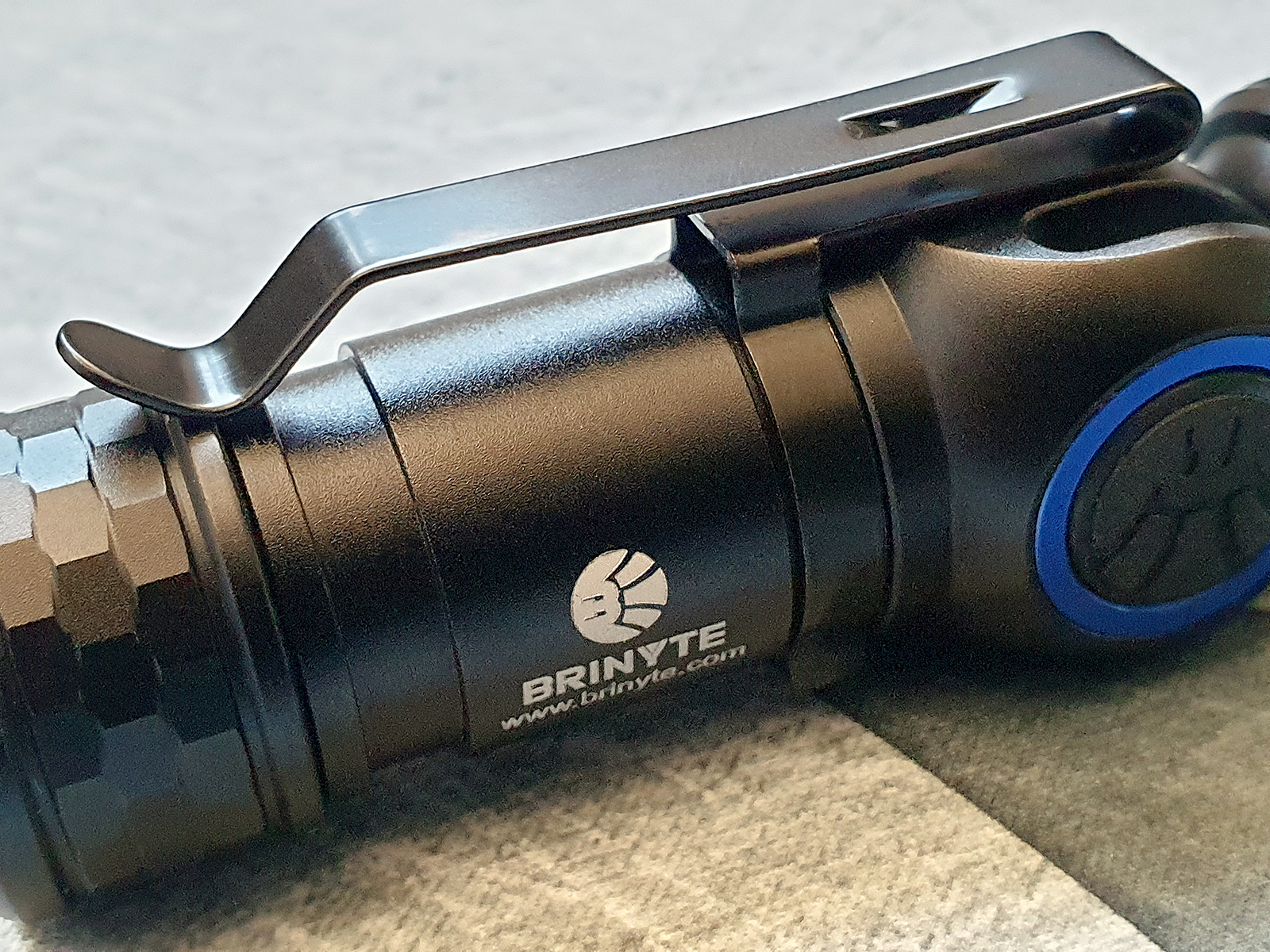
It can easily be removed and installed in the bezel down carry orientation, which makes the torch a very deep carry.

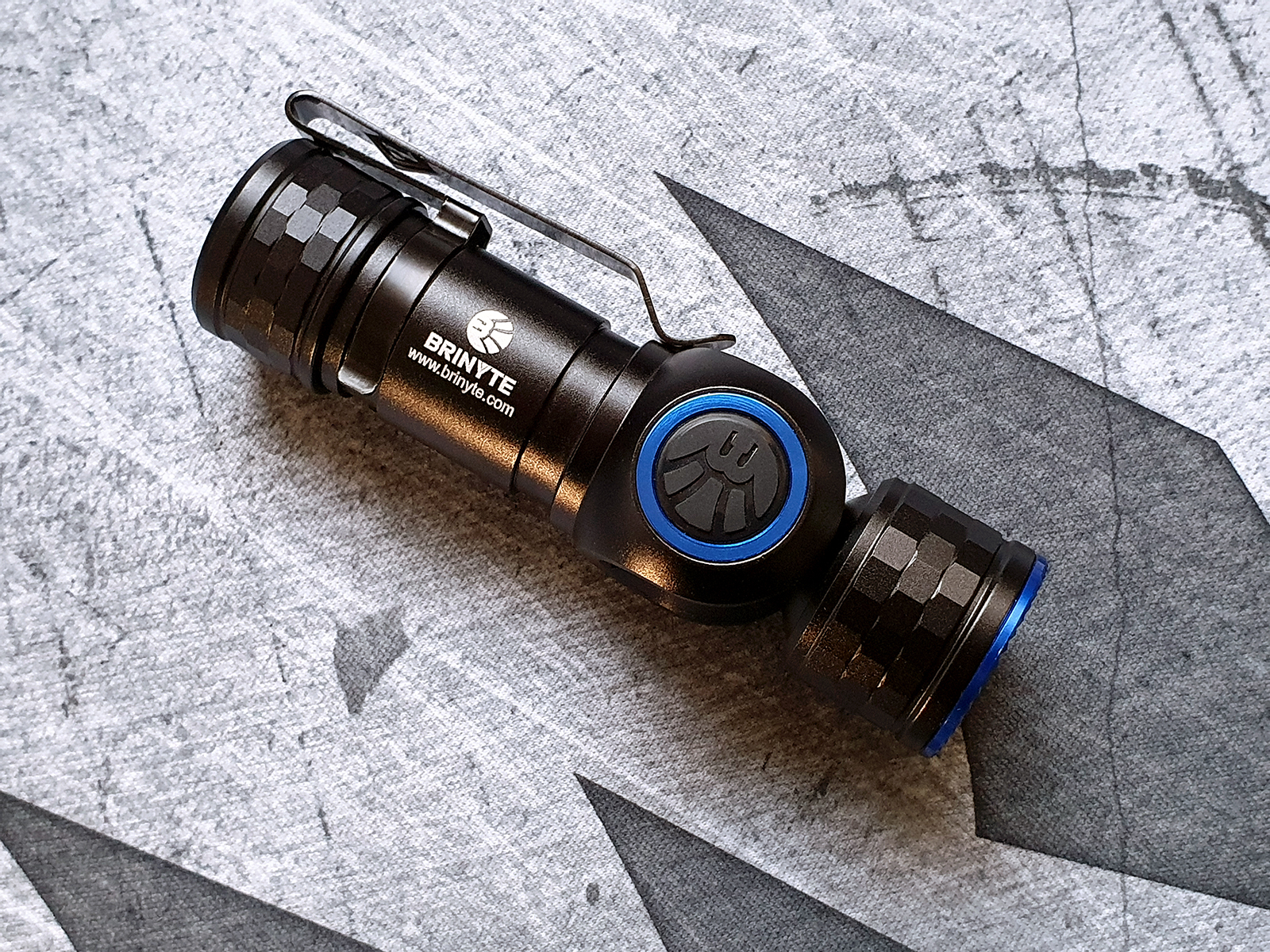
With the clip removed, the Brinyte HL16 Noctua can be mounted onto the head strap.
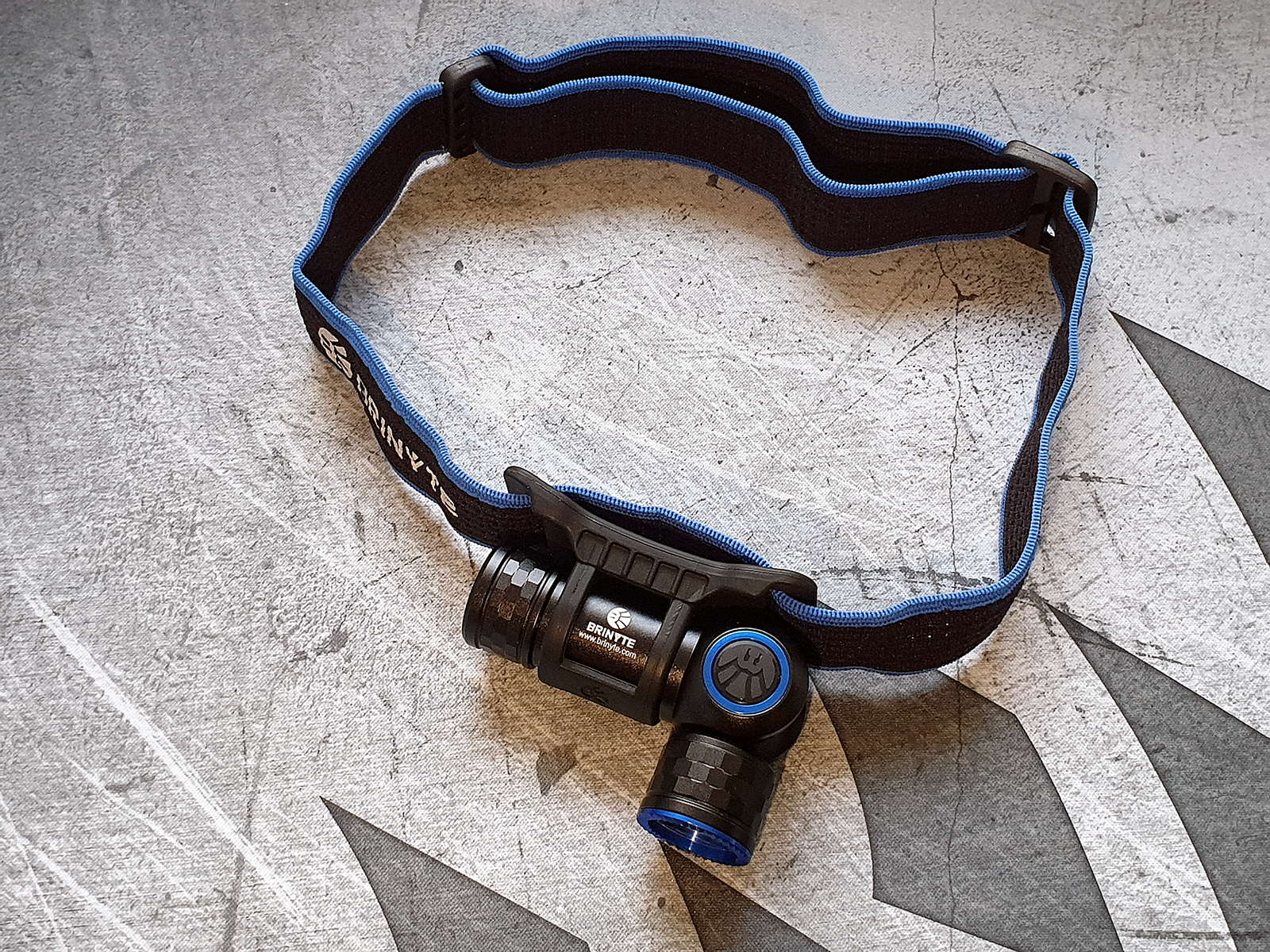
The front of the light features a crenelated bezel with an eye catching design. Inside the head sits a smooth reflector, which is unusual for a head torch as it will increase the throw, but taking into account that it is not very deep and that the torch is a multifunctional one, it was probably chosen to balance the beam for all uses.
The tail cap is smooth and features a magnet that is not very strong but can hold the weight of the Brinyte HL16 Noctua in any orientation.

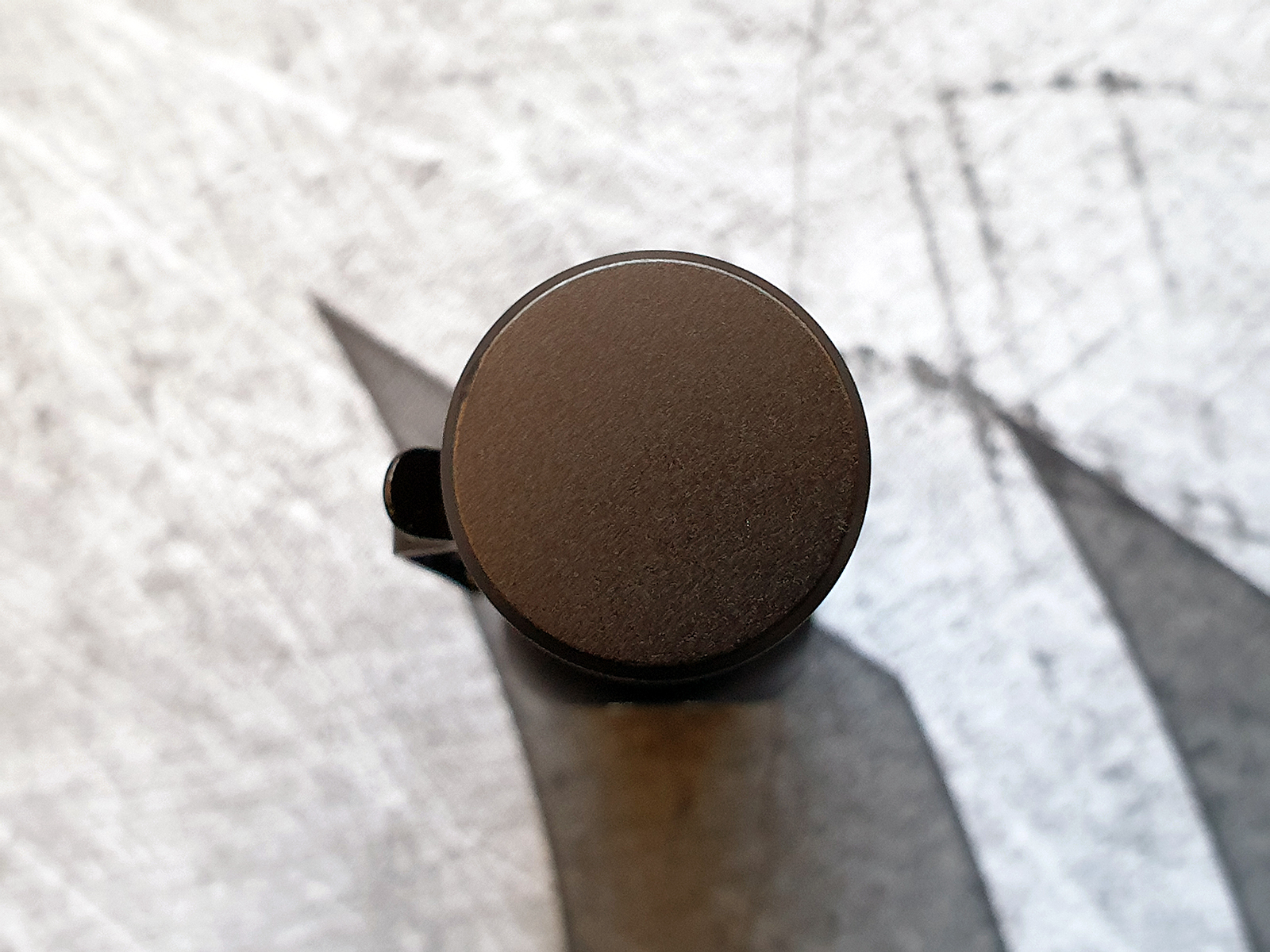
Unscrewing the tail cap reveals the insulating film blocking the negative pole of the battery from making contact with the spring of the tail cap. Let's remove it.

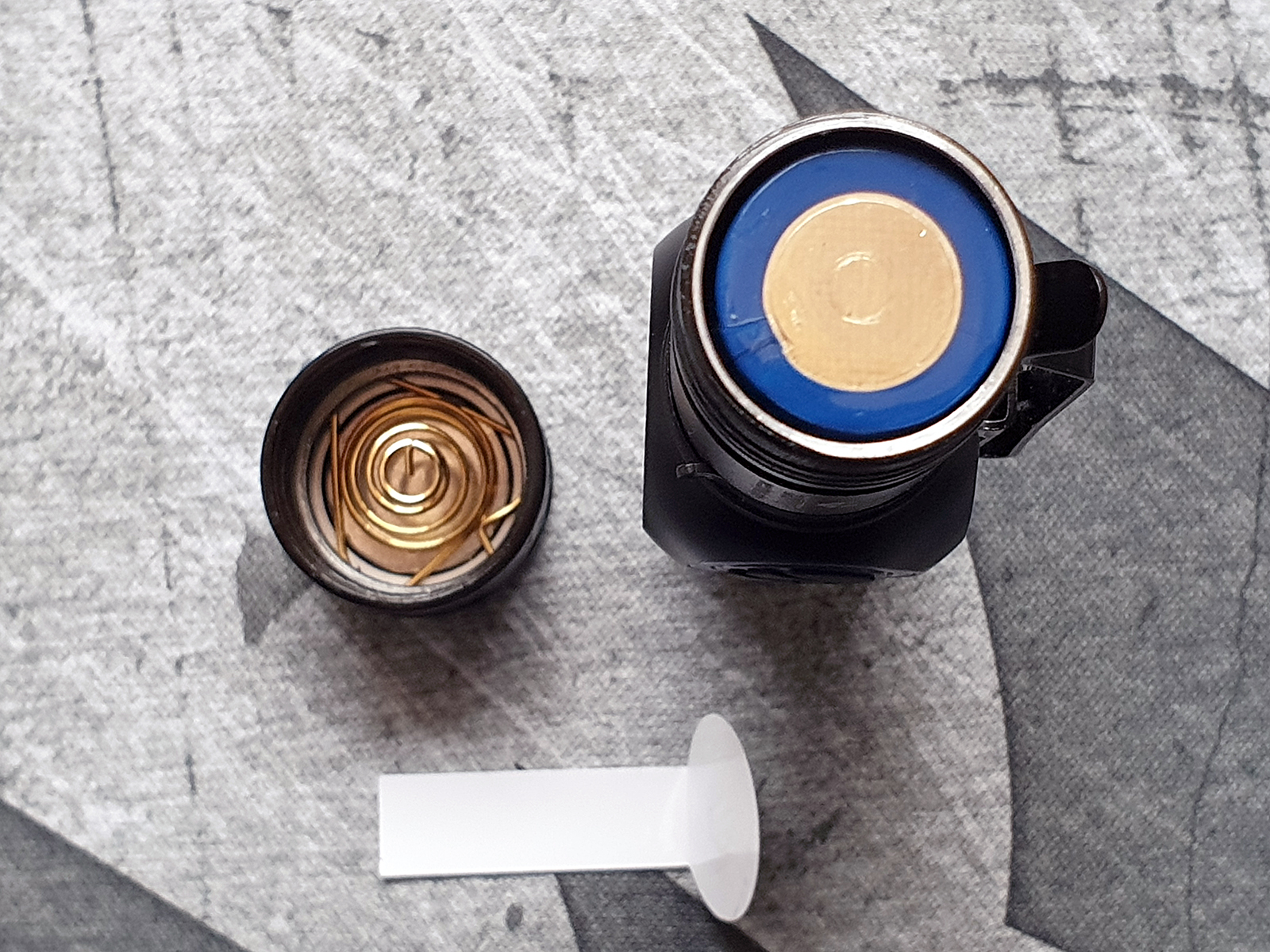
The included battery is a Brinyte branded 16340 Li-Ion battery, with a rated capacity of 650mAh.
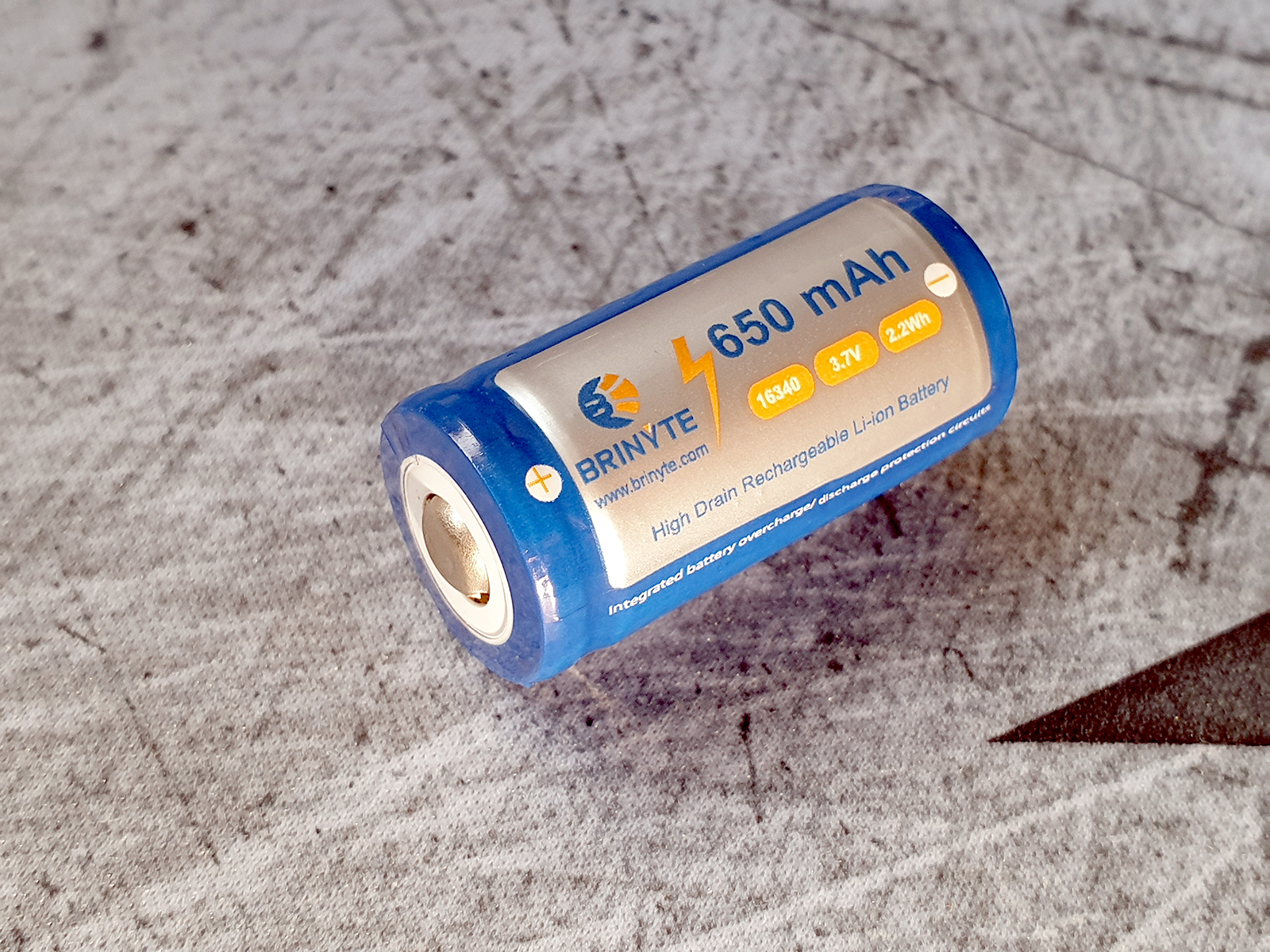
The spring in the tail cap is not thick, but should be sufficient for the current requirements of this torch. The head features a brass button battery contact, with no spring. Despite only having a spring on one side of the battery, hits and bumps did not cause the Brinyte HL16 Noctua to turn off.
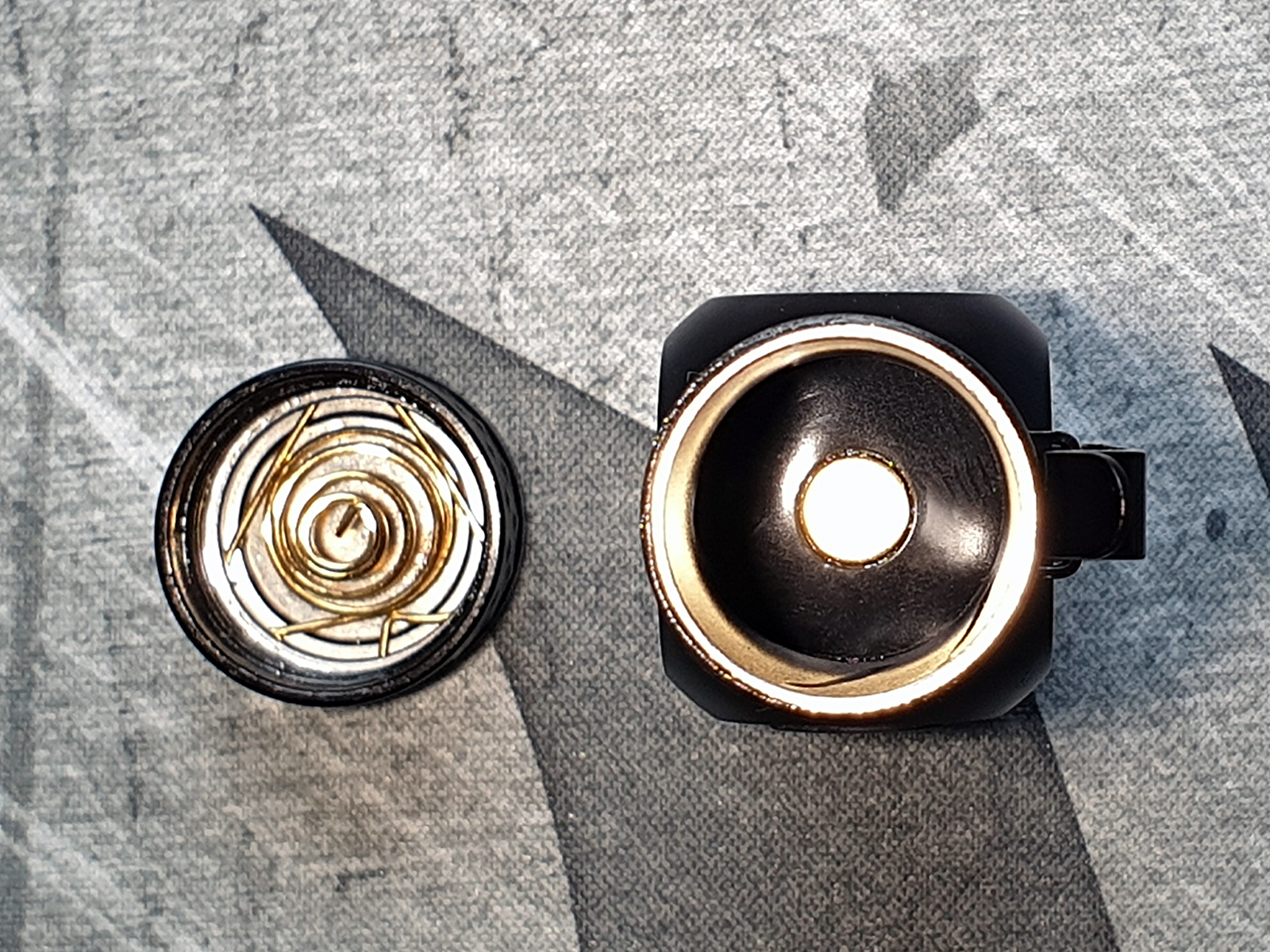
With the insulator film removed and the battery re-installed, the Brinyte HL16 Noctua is ready for action.
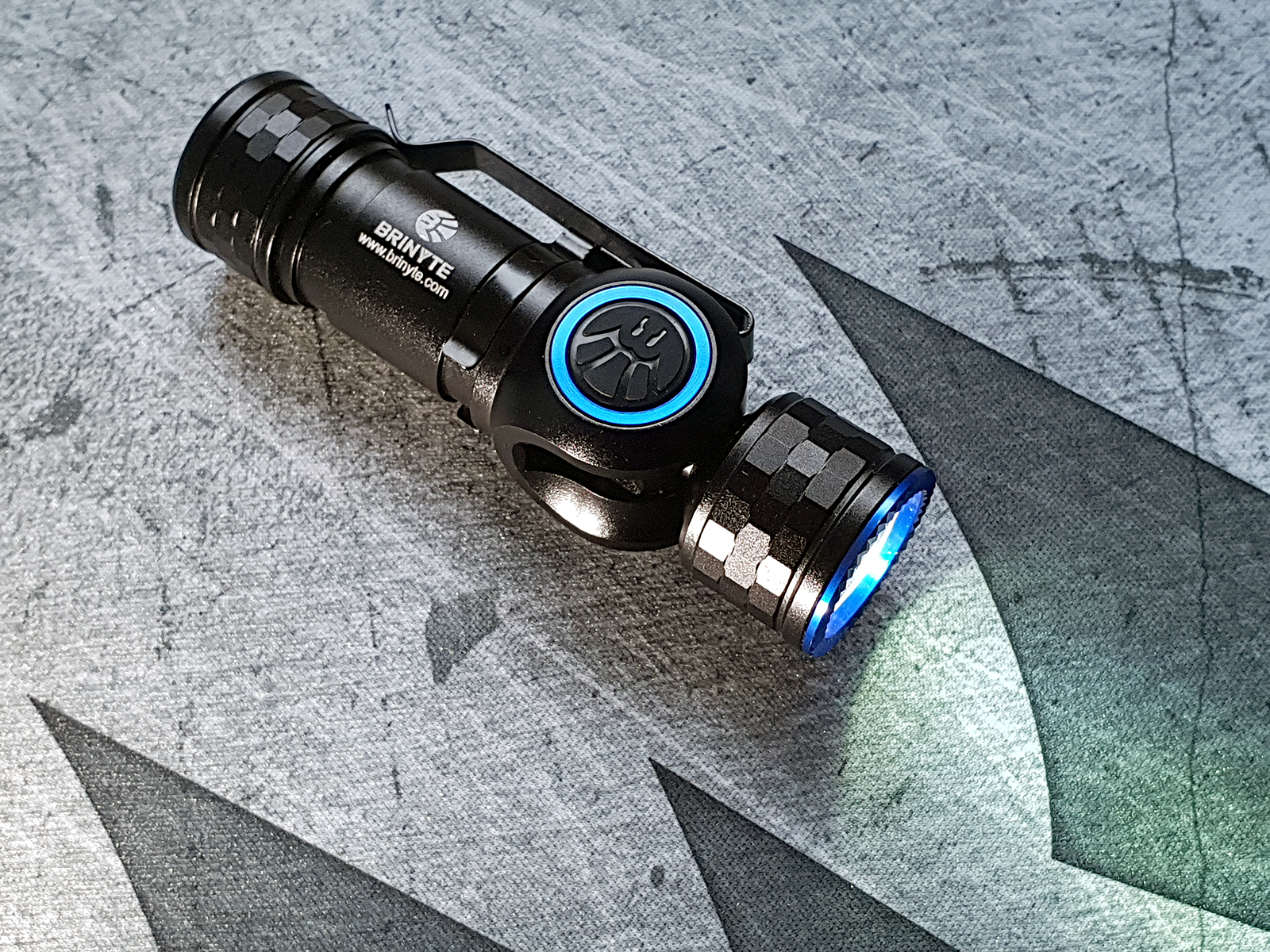
Quality
The build quality of the Brinyte HL16 Noctua does not allow for any complaints.

The fit and finish are excellent, the milling is perfect and the anodization is without any flaws.
Articulated Head
The one unique feature of the Brinyte HL16 Noctua is its articulated head, that will turn from 0 to 90 degrees. The movement of the articulated head is smooth and enjoyable and makes for an addicting fidget toy.
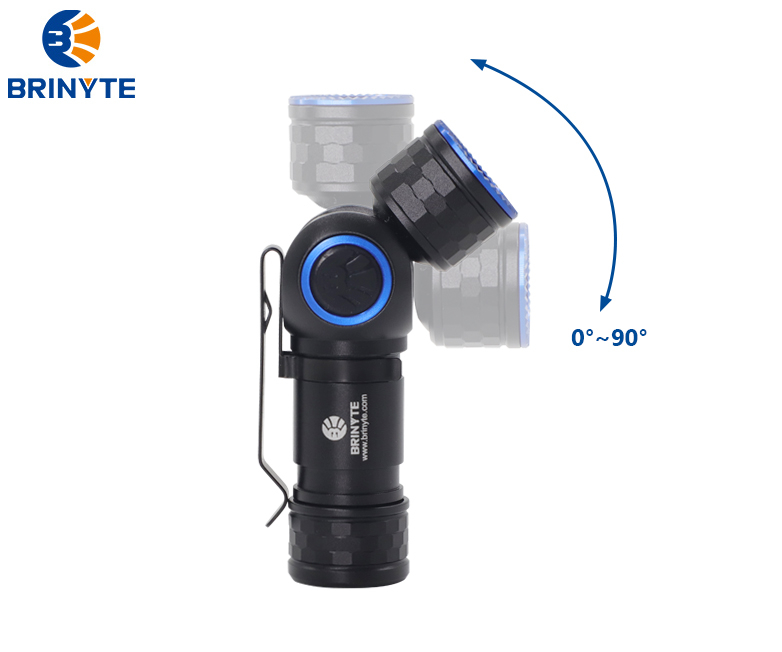
Besides the two extreme positions, the head of the torch will stop in 3, equally spaced, intermediate positions, thus allowing for the light to be directed where it is needed.

This is a very nice and useful feature that I have not seen on any other torch available today.
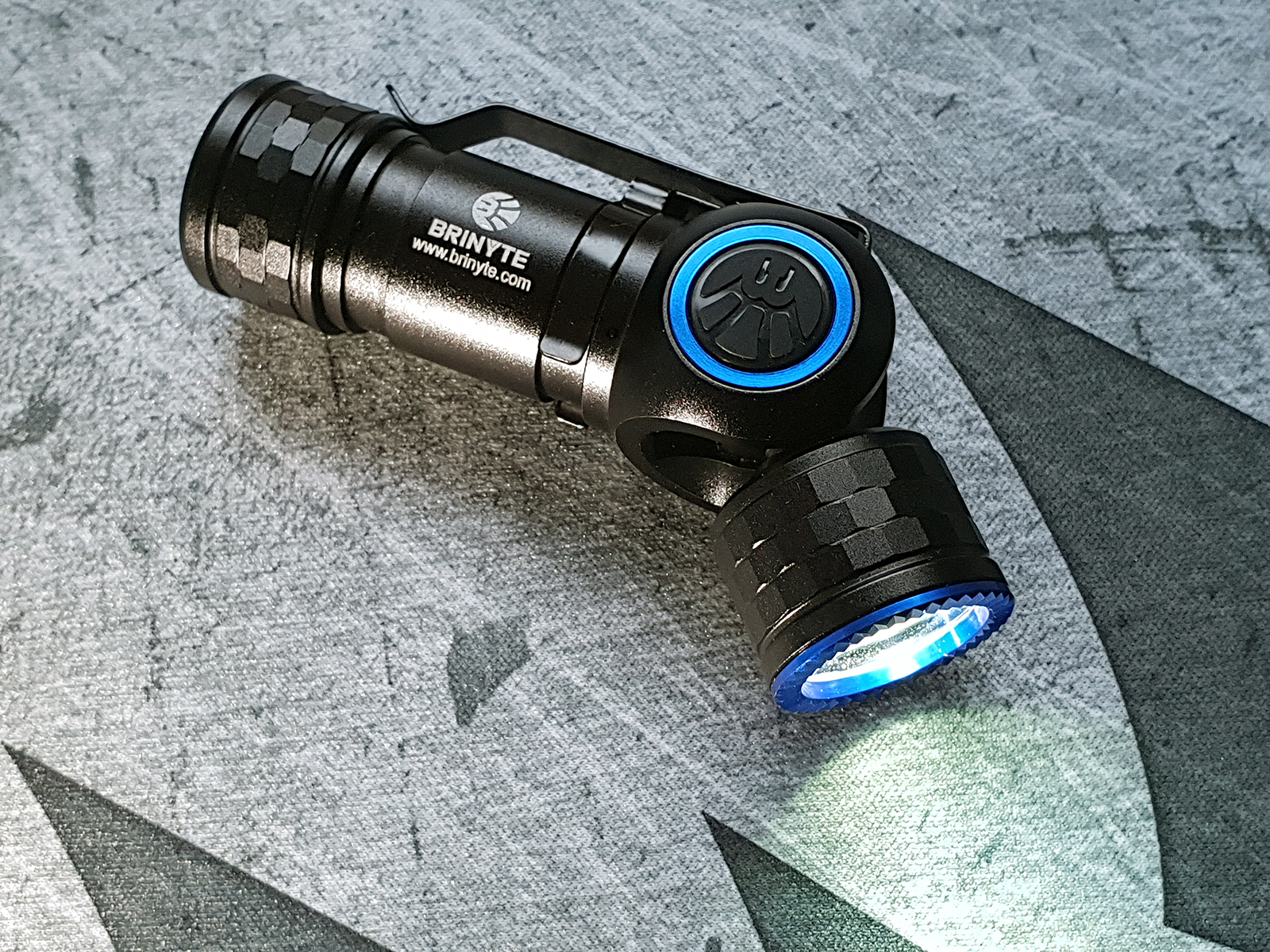
Size Comparison
The following photos offer a direct size comparison of the Brinyte HL16 Noctua to the Olight S1R Baton II. The Brinyte HL16 Noctua is significantly longer, despite using the same size battery. This is a compromise Brinyte had to make to achieve the articulated head design. Nevertheless, the torch is still easily pocketable and the added functionality of the articulated head is worth the extra length.
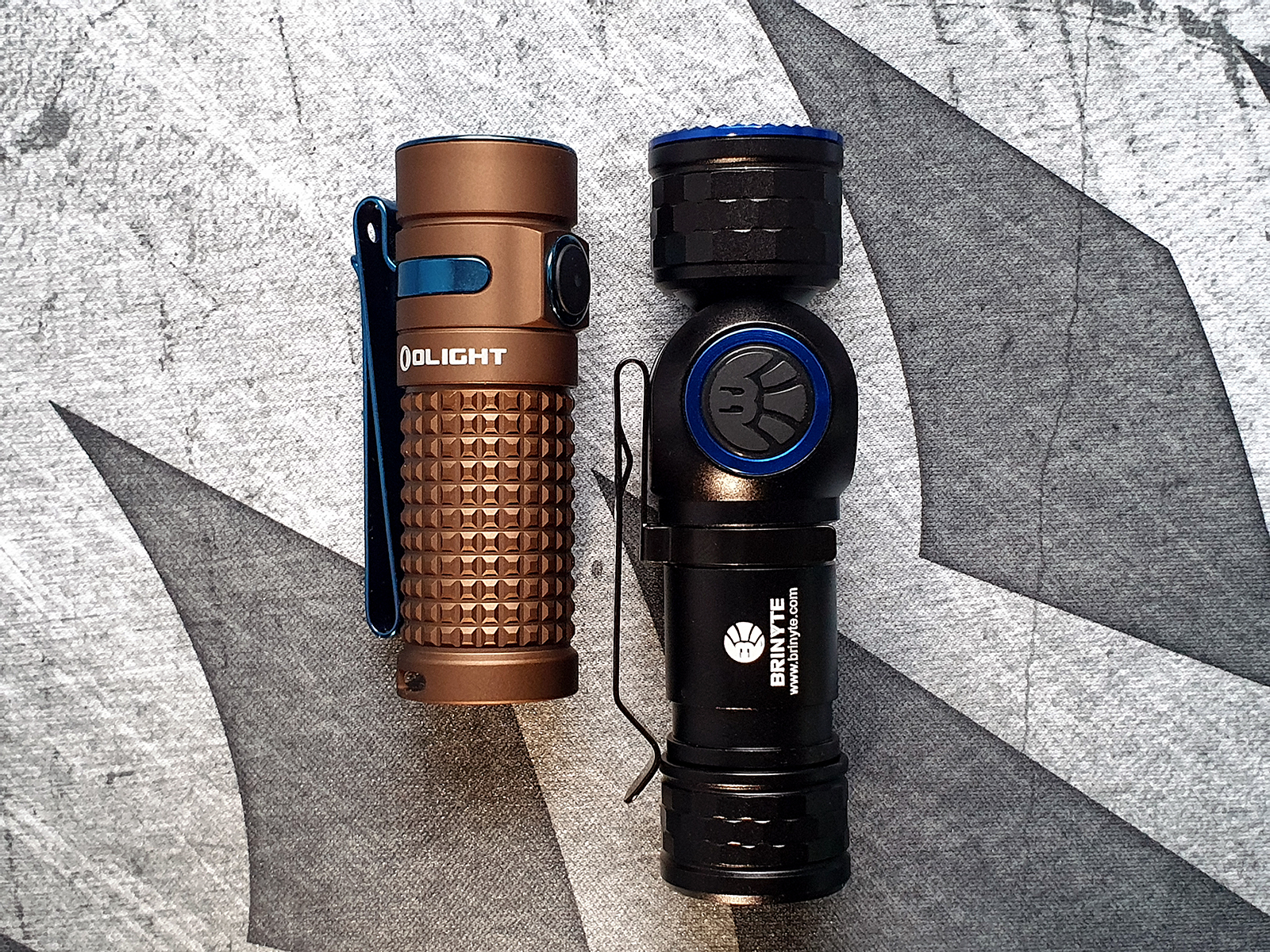
Tint and Beam Profile
The tint of the Brinyte HL16 Noctua is above the BBL (greenish). It is similar to the tint of the Olight S1R Baton II but warmer, although that could easily just be due to the tint lottery. The emitter used in the Brinyte HL16 Noctua is not high CRI.
We can also see from the angle of the beams that the Olight S1R Baton II has a floodier beam pattern than the Brinyte HL16 Noctua.

The beam pattern of the Brinyte HL16 Noctua is well balanced although the smooth reflector makes it throw more than the average EDC or head torch. On the other hand, that helps balance the lower power, giving it about the same intensity and throw as the Olight S1R Baton II, despite having about half the Lumen output.
There is a clear hot spot surrounded by the spill which gradually fades out. No ugly artefacts, despite the smooth reflector.
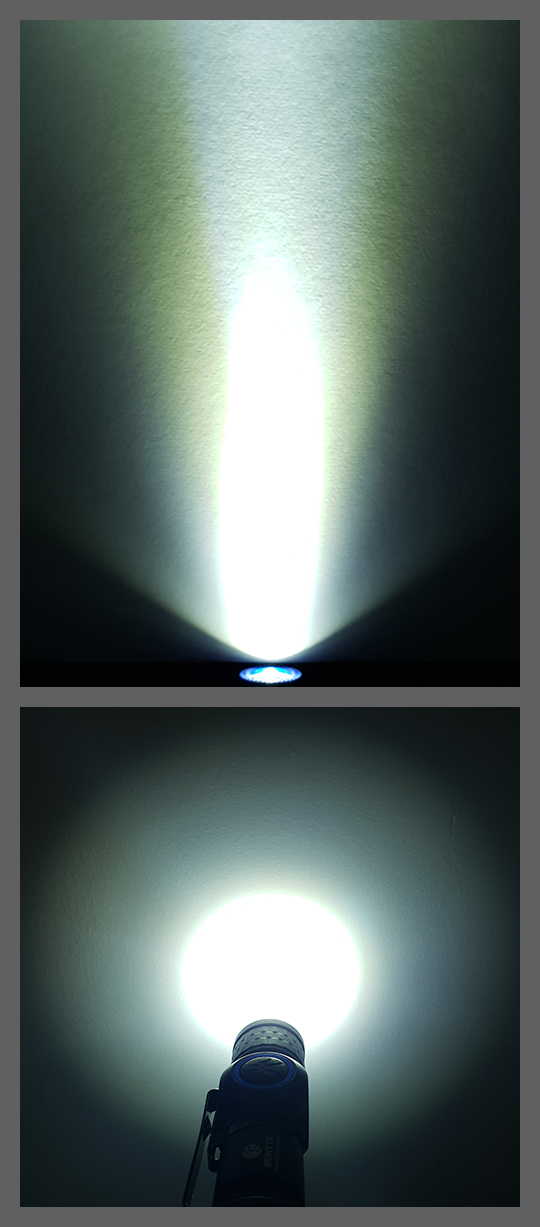
Beam Shots
I tested the Brinyte HL16 Noctua over a distance of 70m.

The following video shows a comparison of the Brinyte HL16 Noctua to the Olight S1R Baton II.
Driver
The driver of the Brinyte HL16 Noctua is a linear, unregulated driver that uses PWM to dim the light, on all levels, except, of course, on full (High). The PWM is visible to the camera but not visible to the naked eye, on any level.


Even though I prefer constant current drivers, PWM is an efficient and cost effective way to achieve LED dimming and if it is done at a high enough frequency, as seems to be the case here, it is not a problem. The driver features thermal regulation, low voltage protection, over charge protection and reverse polarity protection.
Specifications
The specifications of the Brinyte HL16 Noctua , as found on the company's website, are as follows:
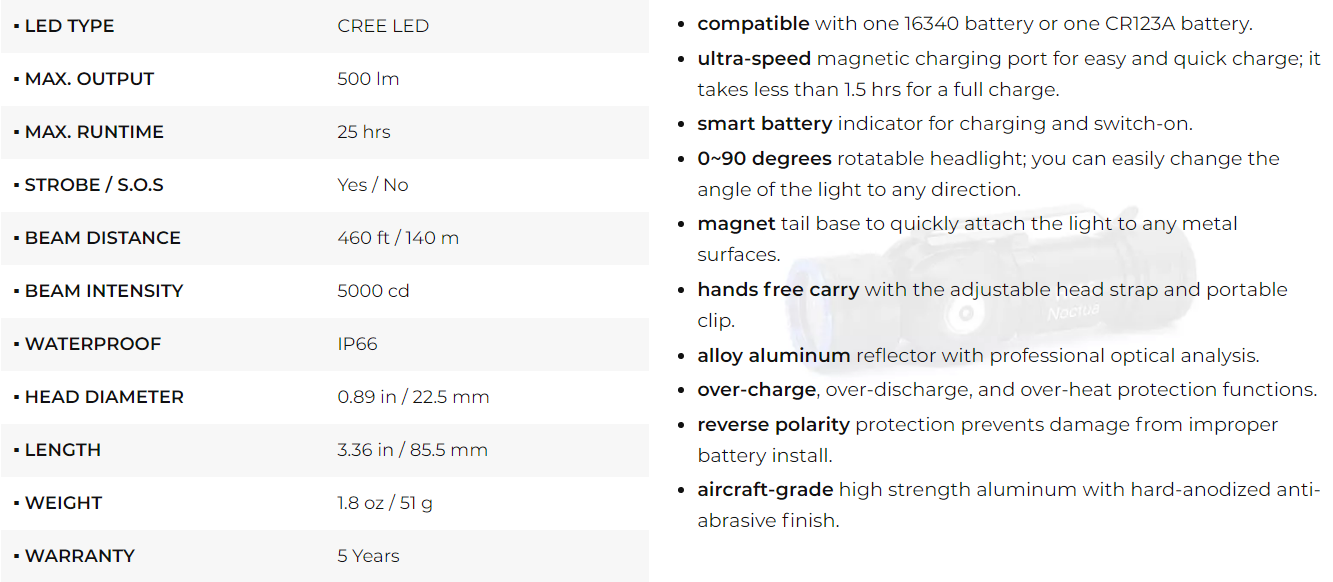
Despite the table stating that the maximum output is 500 Lumen, the actual advertised output as stated in the manual is 520 Lumen. I have made Brinyte aware of the mistake in the table and they will correct it.
The output is lower than other contemporary torches of this size and that is the 2nd compromise that Brinyte had to make so that the Brinyte HL16 Noctua can have its articulated head. This is because the thermal mass of the head is too small and the thermal conductivity through the articulation is too restricted to allow for higher output. Nevertheless, 520 Lumen is more than enough for any task expected from a torch of this size and the articulated head will definitely come in more useful than a few seconds of extra brightness.
The Brinyte HL16 Noctua is IP66 rated which means it is dust tight and can withstand powerful water jets, but it cannot be submerged. That is the 3rd and final compromise, after the limited maximum output and longer body, that Brinyte had to make to allow for the articulated head. IP66 is more than adequate for normal use and unless you drop your torch into a puddle, you should be alright using it in any situation.
The drop resistance rating is a respectable 1.5m, so the articulated head does not seem to limit the durability.
The maximum throw is 140m, which is a lot for the 520 Lumen rating and is due to the smooth reflector.
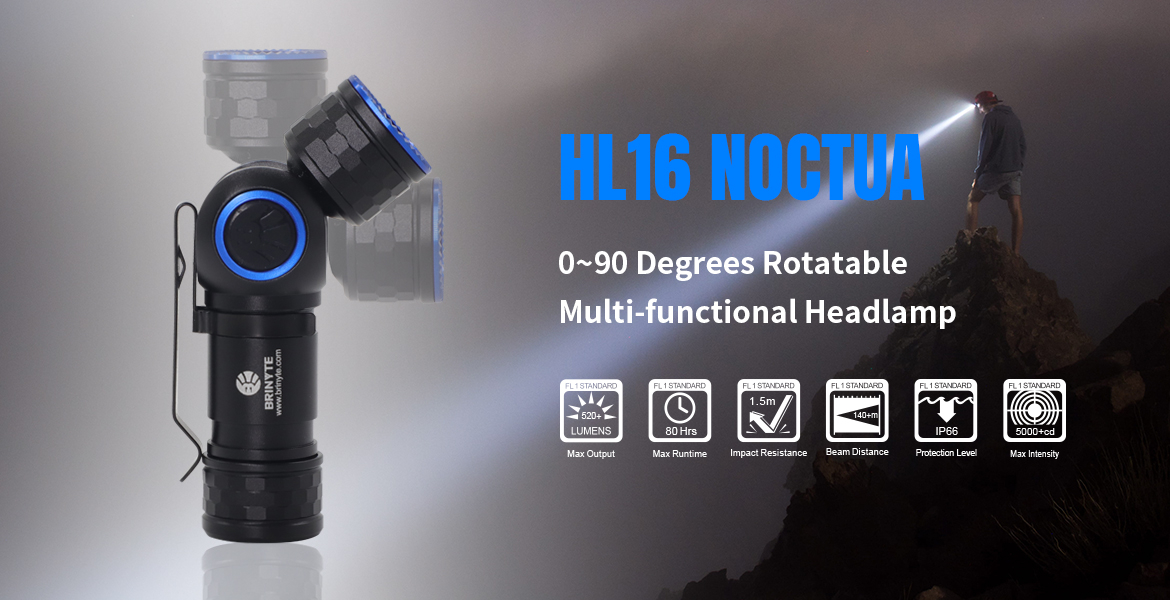
User Interface
The user interface of the Brinyte HL16 Noctua is very simple and can be seen in the following animation.
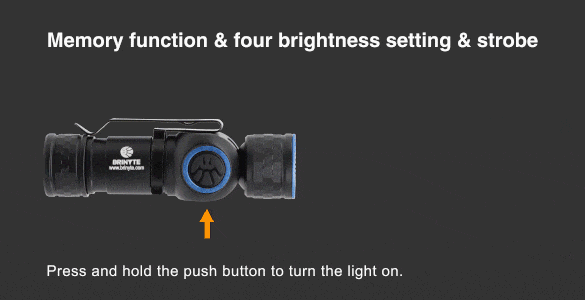
- To turn the torch on, press and hold the button until it lights up. The torch features mode memory, so it will turn on at the last used mode.
- Press the button to cycle between the 4 main modes: High, Medium, Low, Moon.
- Press and hold the button to turn the torch off.
- Double click the button at any time to enter Strobe mode. Press again to go to the previously used mode.
I disagree with the company's decision to make the UI go from high to low as I find this counter intuitive, especially on an EDC or head torch. When I am on Moonlight and need a little more light I would like to be able to go to Low without having to be blinded by High first.
I also miss the ability to turn the torch on at Moon mode, regardless of the previously used mode. Some torches use press and hold from off to go straight to Moon mode, but as the Brinyte HL16 Noctua uses press and hold to turn on, this is not possible. I understand that the press and hold to turn on choice makes a lock function unnecessary, but I would prefer a Moon shortcut and a lock function.
Modes and Run Times
The brightness of the modes and the respective run times, according to the manual, are shown in the table below. I have added a row with my own measurements.

It is very refreshing to see a company that does not overestimate their product's Lumen output! Kudos to Brinyte!
Current Draw
As the UI of the Brinyte HL16 Noctua goes from High to Low, so will our current draw measurements. The torch draws just over 1.4A on High, just over 0.5A on medium, 134mA on Low and 13mA on Moonlight level.

The current requirements are not demanding and the battery is a standard 16340, so the Brinyte HL16 Noctua has the advantage to be able to run on any 3.7V Li-Ion 16340 battery.
Charging
The battery included with the Brinyte HL16 Noctua is rated at 650mAh and I measured it at 697mAh. The battery's internal resistance was measured at around 112mΩ. It is clear that the battery included with the Brinyte HL16 Noctua is of high quality. Another positive point for Brinyte.

The torch has under voltage protection and turns off when the battery voltage drops to 2.77V. The indicative LEDs around the magnetic charging port are lit green during operation if the battery charge is from 100% to 40%, lit red if it is from 40% to 5% and blink red if it is below 5%.

Charging the Brinyte HL16 Noctua is very easy. Just use the included magnetic cable that automatically attaches to the torch when you get it near enough. The other end of the cable is a standard USB A plug and can be connected to any USB charger or computer USB port.
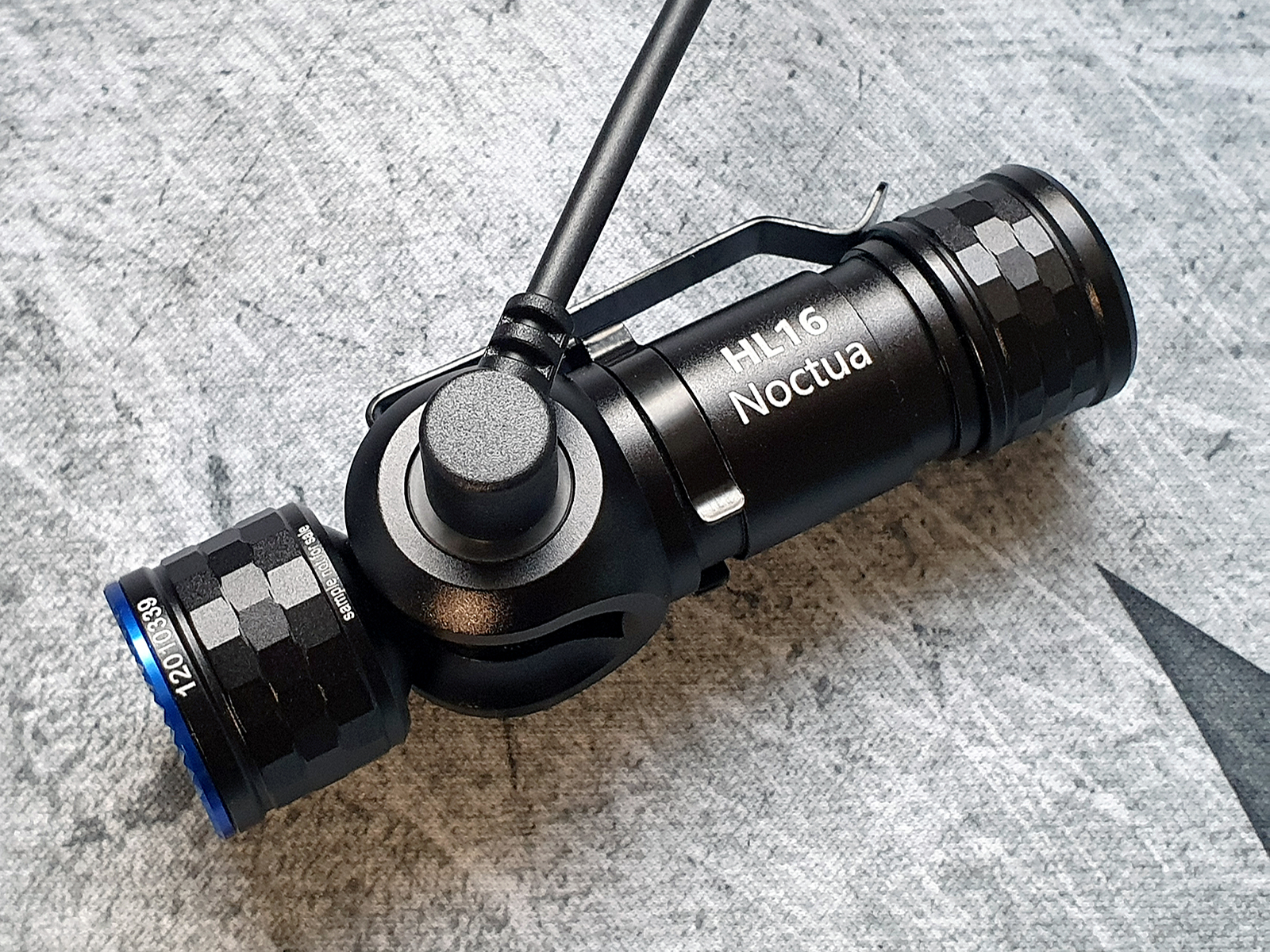
The indicative LEDs around the charging port will turn red while the torch is charging and turn green to indicate a full charge.
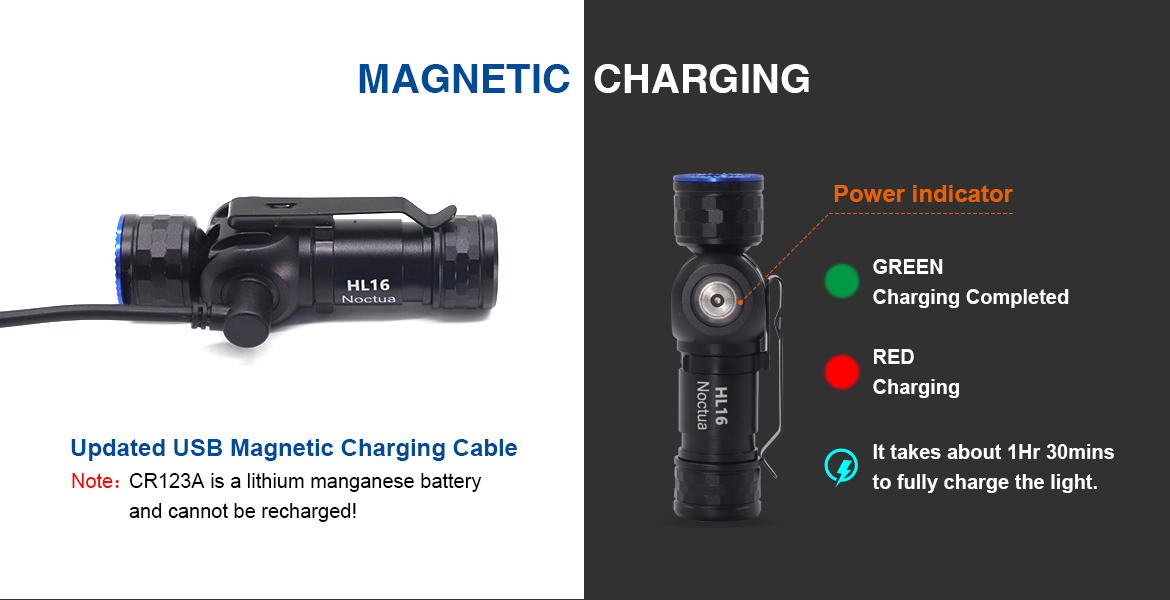

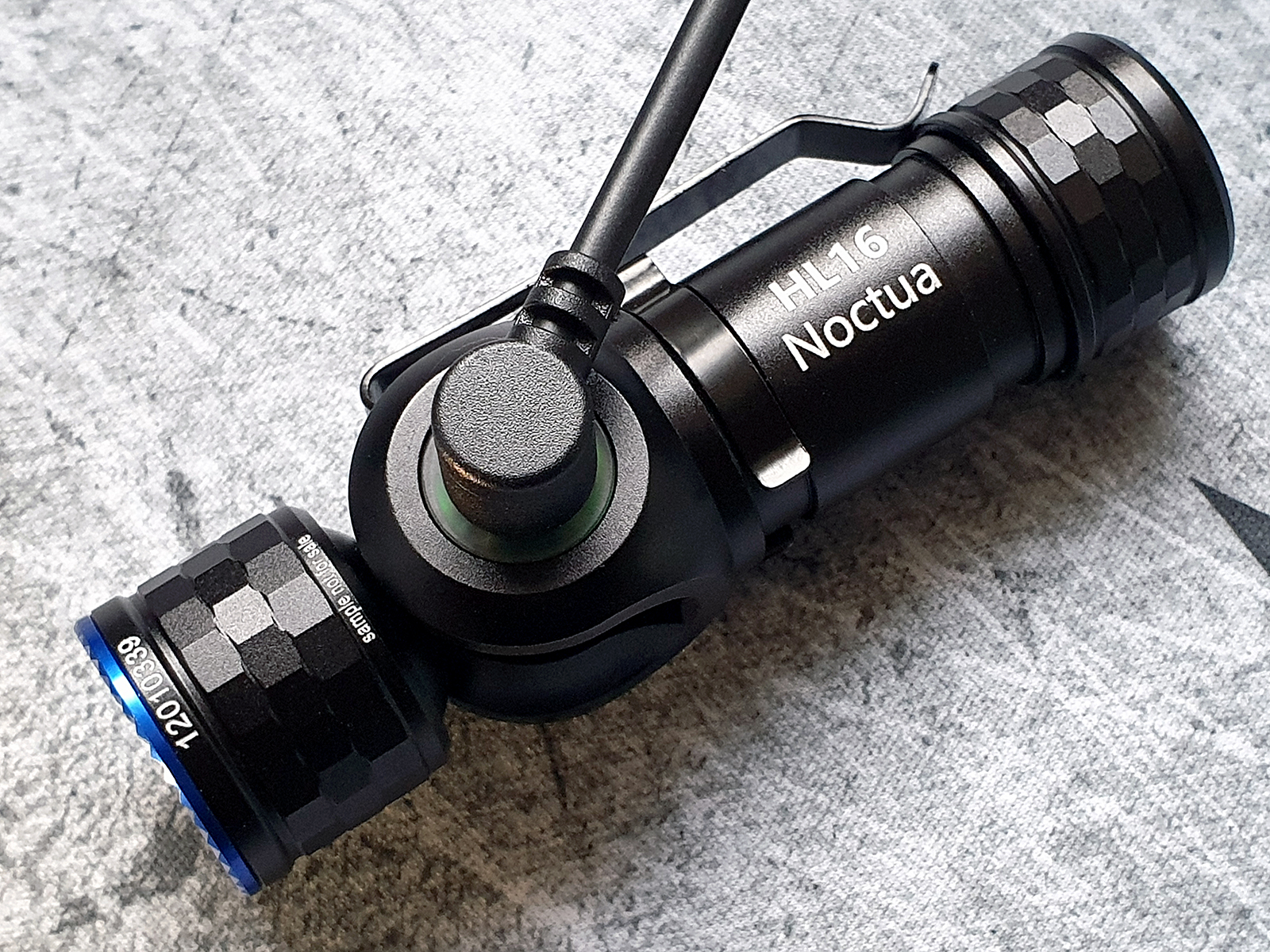
Charging the Brinyte HL16 Noctua from 2.77V to 4.18V, where the charging terminated, took 2 hours, 18 minutes and 51 seconds. The maximum current drawn was 0.5542A, so any USB charger or computer USB port will be sufficient. A charger is not provided with the light but you can use your phone charger.
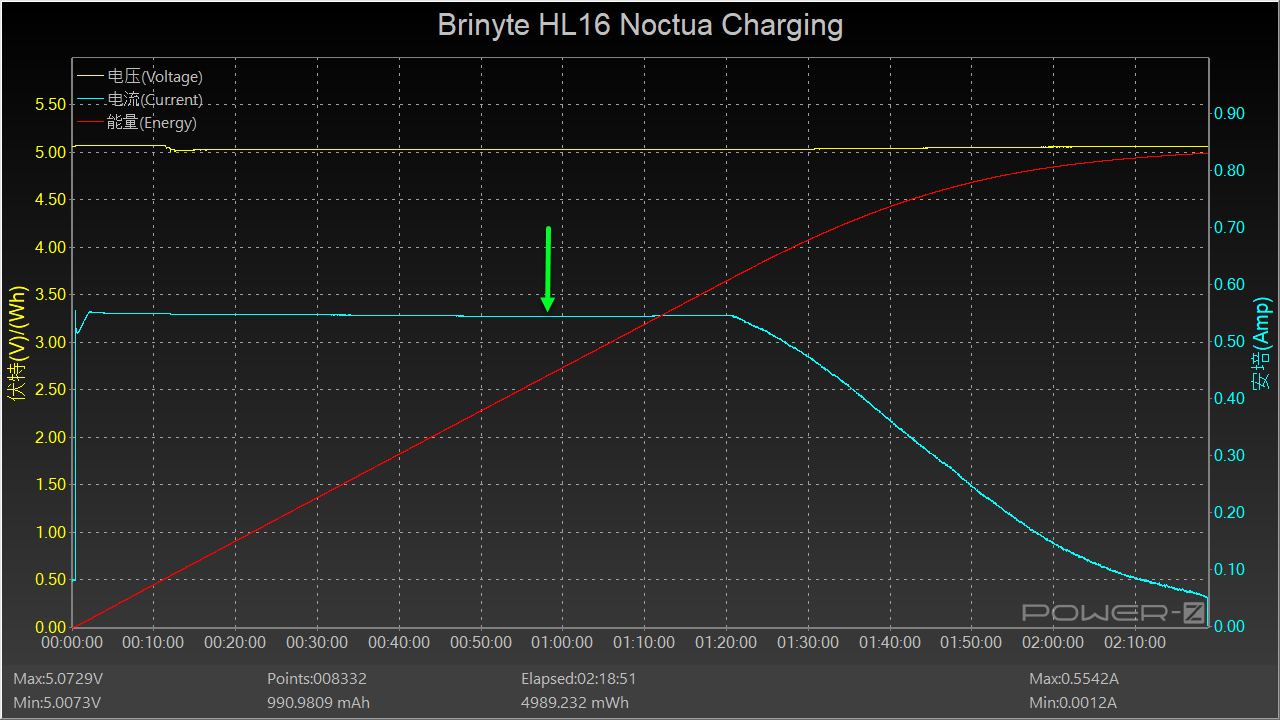
Unfortunately, the indicative LEDs turned green way before the charging was actually completed, indicated by the green arrow in the chart above. The voltage of the battery at that point was around 3.9V and there was still a long time to go and a lot of energy the battery could absorb and store before the charging actually completed.
This is a practice that some other companies, such as Olight, have as well and with which I do not agree. Brinyte maintains that this increases the battery life as it is not fully charged every time and also that most users will not take the torch off the charger the moment the indicative LEDs turn green.
In my opinion, this is nonsense. I want to know when my battery is actually fully charged and not have to guess (or use measuring equipment as above) and if I want to give my battery a full charge to get the full run time it is for me, the user, to decide. Having indicative LEDs that lie to me and having to leave the torch on the charger for a longer time, with no visual indication of when the charging is actually completed is most inconvenient and has no advantage whatsoever.
Output & Runtimes
The Brinyte HL16 Noctua is rated at a maximum output of 520 Lumen and a maximum throw of 140m.
I do not own a multi thousand dollar worth integrating sphere, just a logging Lumen meter and a home made integrating tube. The array is calibrated with 3 separate, professionally measured lights and gives me consistent results, but there is definitely room for error and deviations are to be expected.
According to my measurements, the maximum output (at turn on) was 556 Lumen, which is 7% more than the advertised 520. ANSI output (at 30 seconds) was 510 Lumen and at 2 minutes it was still 463 Lumen. Then the output declined rapidly over the next 38 seconds to 315 Lumen. It then followed the gradual declining curve of the battery output and gave useful light for over an hour, as the specifications promise.
The rest can be seen in the graphs below. The first graph is the full runtime graph.
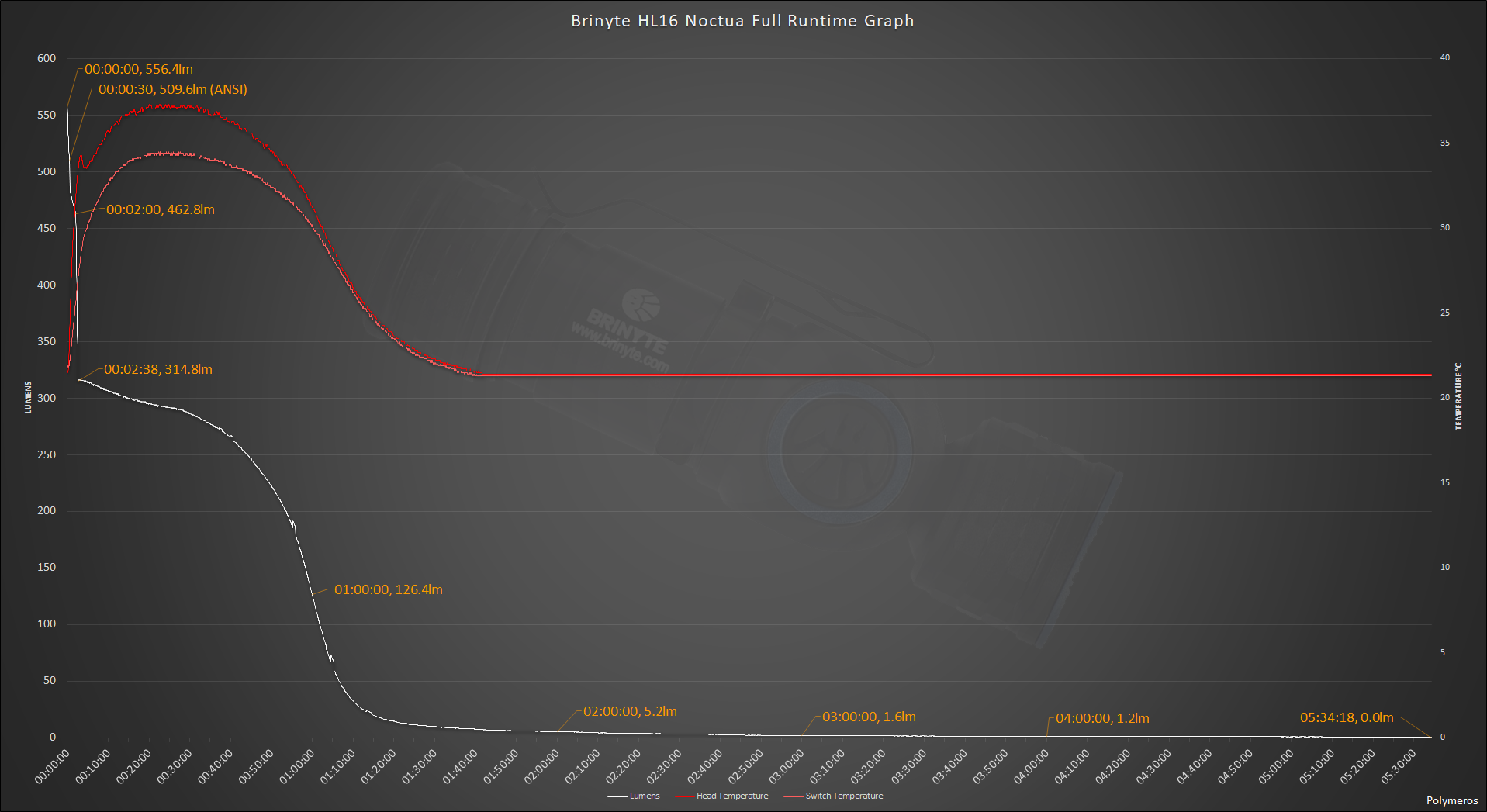
And here are the first 10 minutes, in greater detail.
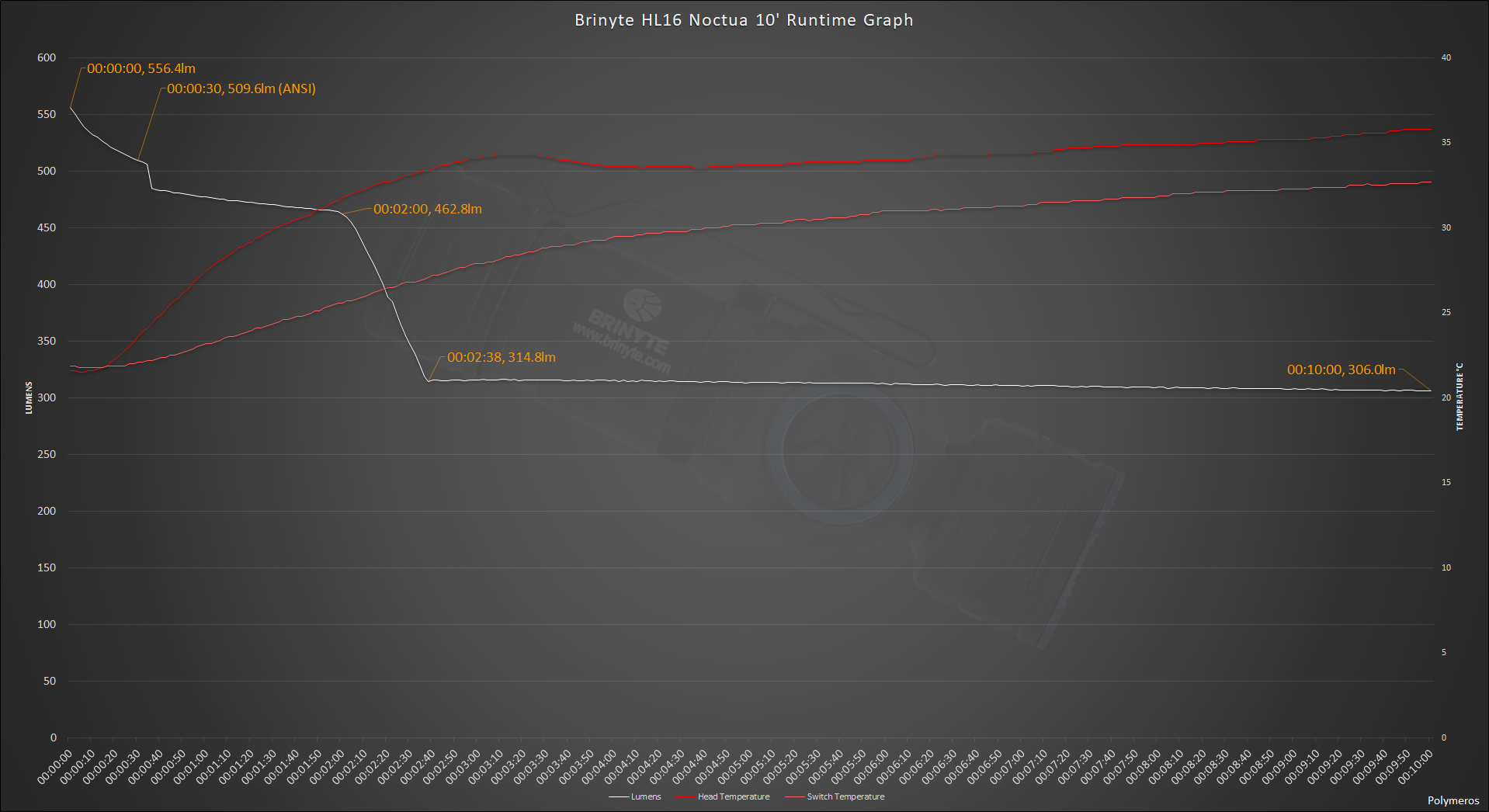
At the end of the battery life, the very low output fluctuates as the indicative LED flashes red to show that the remaining battery capacity is below 5%.
The temperature was very well controlled, as you can see in the runtime graphs. The head and switch temperatures are close but there is some difference despite their close proximity, which demonstrates the thermal impedance of the articulated head.
The maximum intensity of the light was measured at 5002.4cd, which translates to a throw of 141m. That is 1m more than the 140m advertised.
Conclusion
The Brinyte HL16 Noctua is a unique EDC sized head torch with excellent build quality and an articulated head which allows it to turn its beam from 0 to 90 degrees relative to the body of the light, including 3 intermediate stops. Its aluminium body is well made and hard anodized and the fit and finish are flawless.
The torch meets and exceeds all of its specifications, which is refreshing to see as very few manufacturers respect their customers enough to provide true and accurate measurements.
The head band provided is very comfortable, it is adjustable and the weave allows for ventilation. The clip is unidirectional and very well designed and can be installed in 2 positions, for bezel up or bezel down deep carry.
The driver uses PWM to dim the output, so PWM is present at all output levels, except on High. The frequency of the PWM is high enough to not be visible to the naked eye and did not tire me when using the light.

The unique articulated design of the head of the Brinyte HL16 Noctua imposed some limits on this torch. The maximum output is lower than most comparable sized torches due to the thermal barrier imposed by the articulated head while its total length is increased and its waterproof rating decreased for the same reason. Nevertheless, the advantage provided by the design will outweigh the limitations for many users. Besides, maximum output is only available for about a minute on all small torches and after that, the output of the Brinyte HL16 Noctua is similar to theirs.
The Brinyte HL16 Noctua is currently under mass production and scheduled to be available for purchase at the end of October 2021 from the company's website and the cost will be $69.98. Brinyte have provided a $10 discount code for the readers of this review, which brings the price down to $59.98.
The discount code is: HL16Noctua
Disclaimer: I get absolutely no percentage of the sales or any other personal benefits from Brinyte, except for the fact that the torch was provided for review free of charge.
Let's list the Pros and Cons of the Brinyte HL16 Noctua:

Pros
+ Unique articulated head design that allows for 0 to 90 degrees position, including 3 intermediate stops
+ Measurements show specs to be accurate and not exaggerated, showing respect to the customer
+ Good and balanced beam pattern
+ Good quality head strap
+ Magnetic charging
+ Magnetic tail cap
+ Included good quality battery
+ Low Voltage Protection, Over Charge Protection and Reverse Polarity Protection
+ Thermal regulation
+ Low power and charging LED indicator
+ Good quality unidirectional clip that can be placed in 2 positions, for bezel up or bezel down deep carry
+ Compatible with all 3.7V Li-Ion 16340 and with 3.0V CR123 batteries

Cons
- High to Low User Interface
- Charging indicator indicates charging complete a long time before it is actually completed
- Maximum output limited to 520 Lumen
- Longer than most 16340 torches
- IP rating limited to IP66
- The driver is not regulated and uses PWM to dim the emitter
- The charging cable is a downgrade from the one included in previous Brinyte models
Thanks to Brinyte for providing the torch for review
Polymeros Achaniotis 16/10/2021
-
 11
11



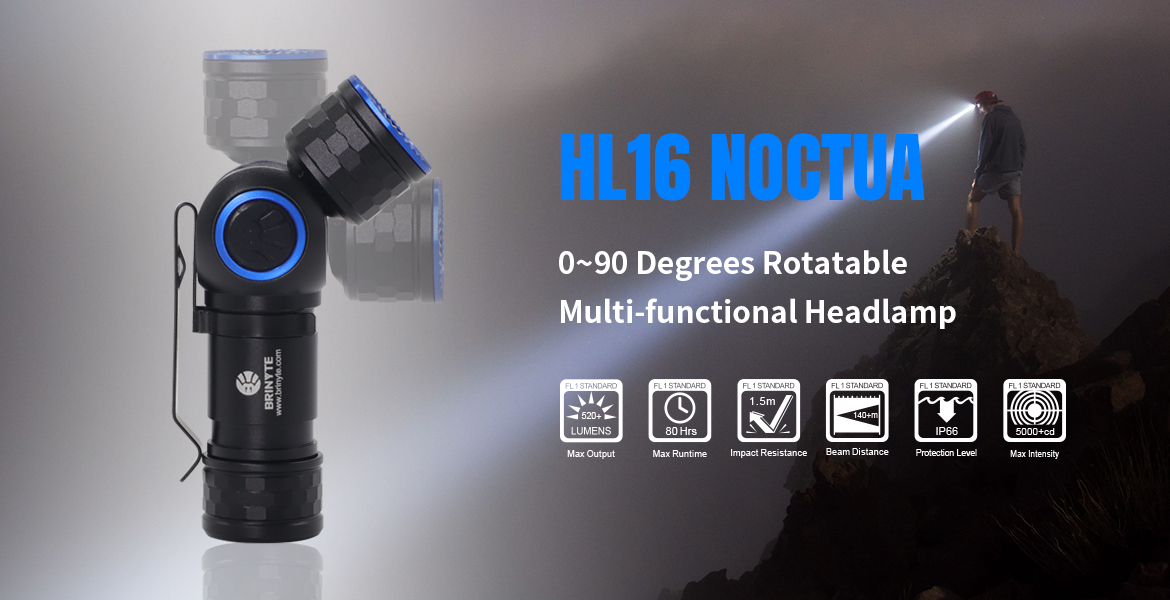
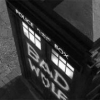




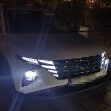

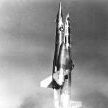


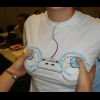

Recommended Comments
There are no comments to display.
Create an account or sign in to comment
You need to be a member in order to leave a comment
Create an account
Sign up for a new account in our community. It's easy!
Register a new accountSign in
Already have an account? Sign in here.
Sign In Now